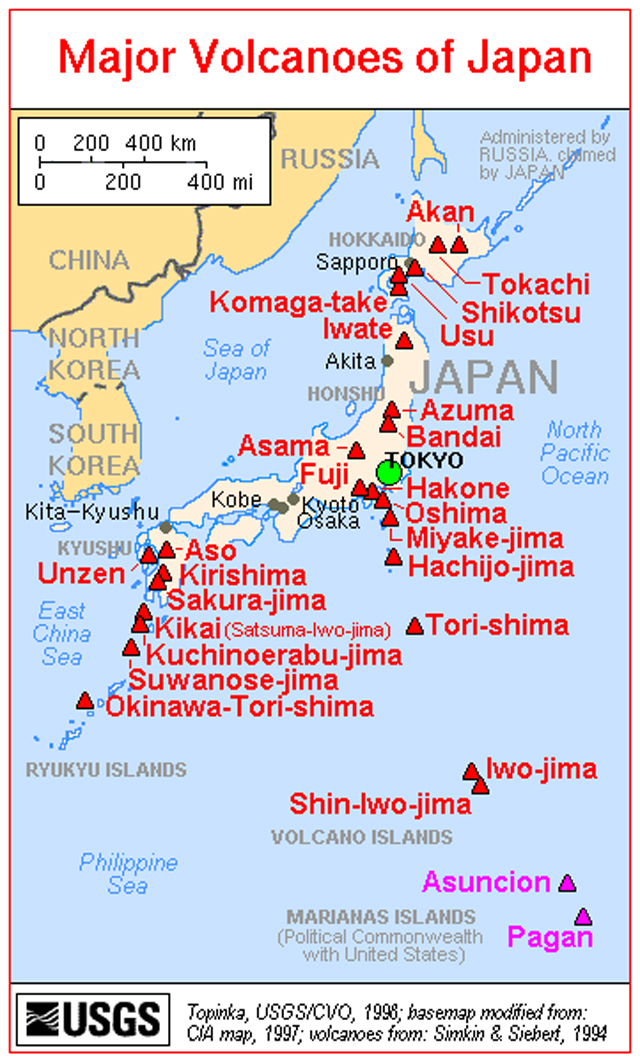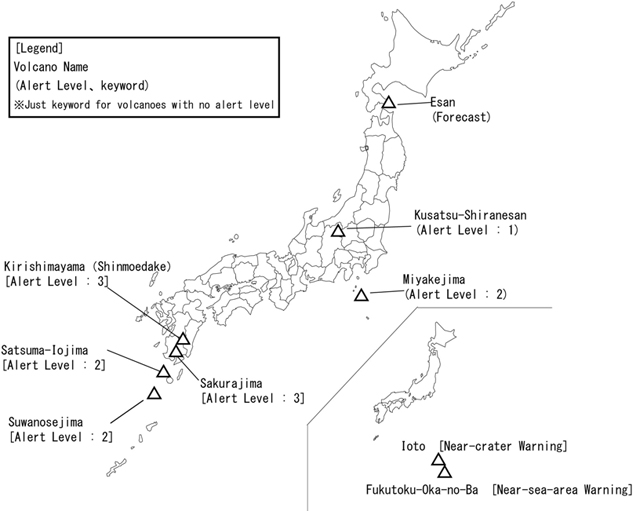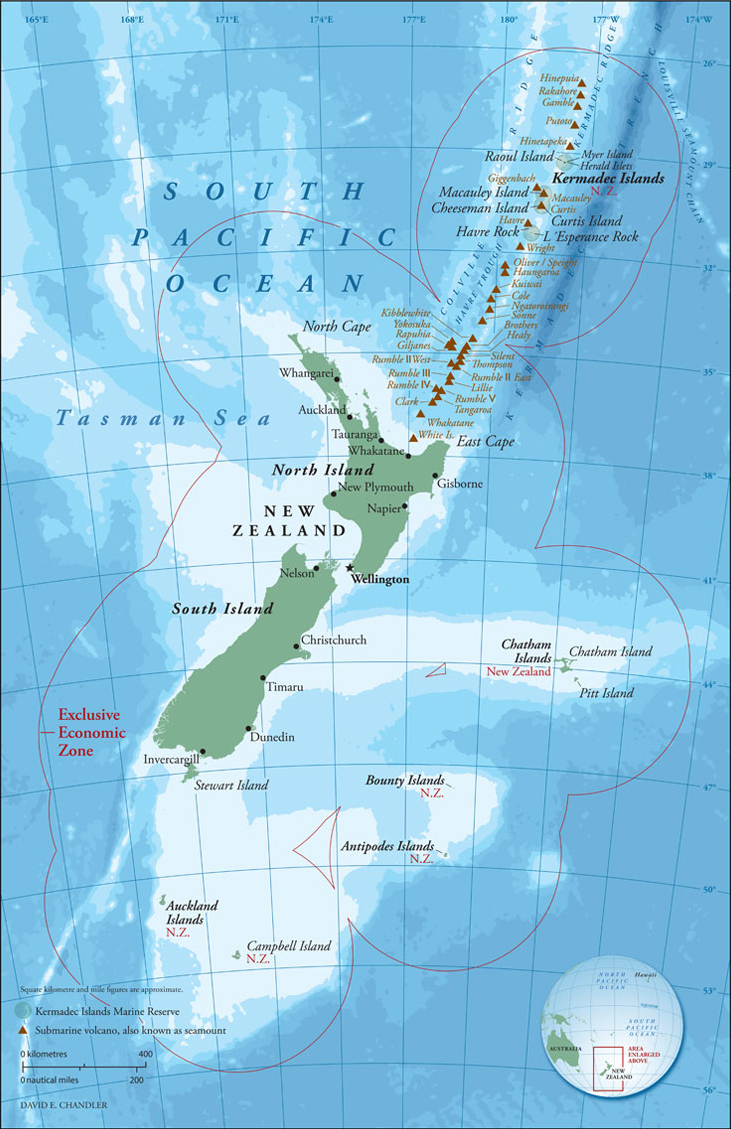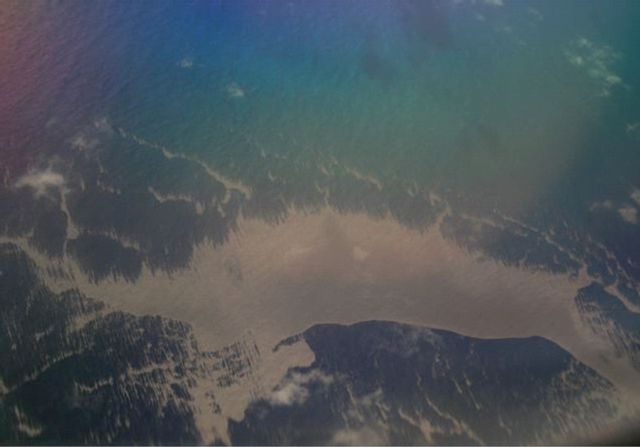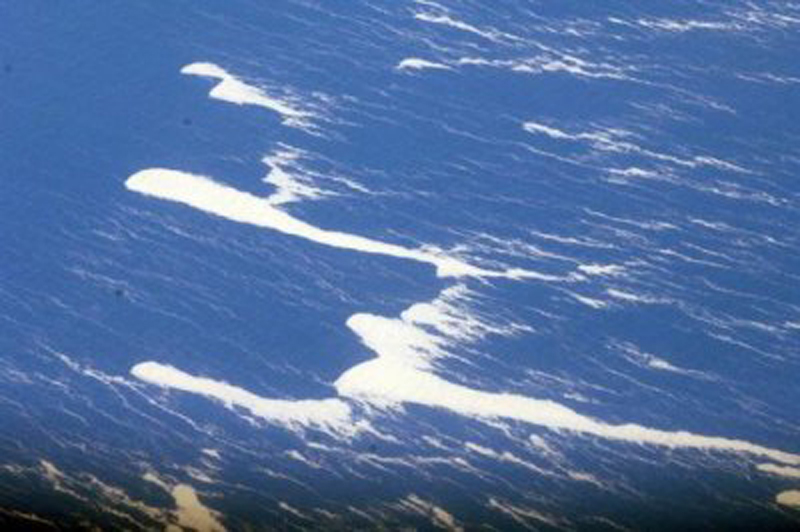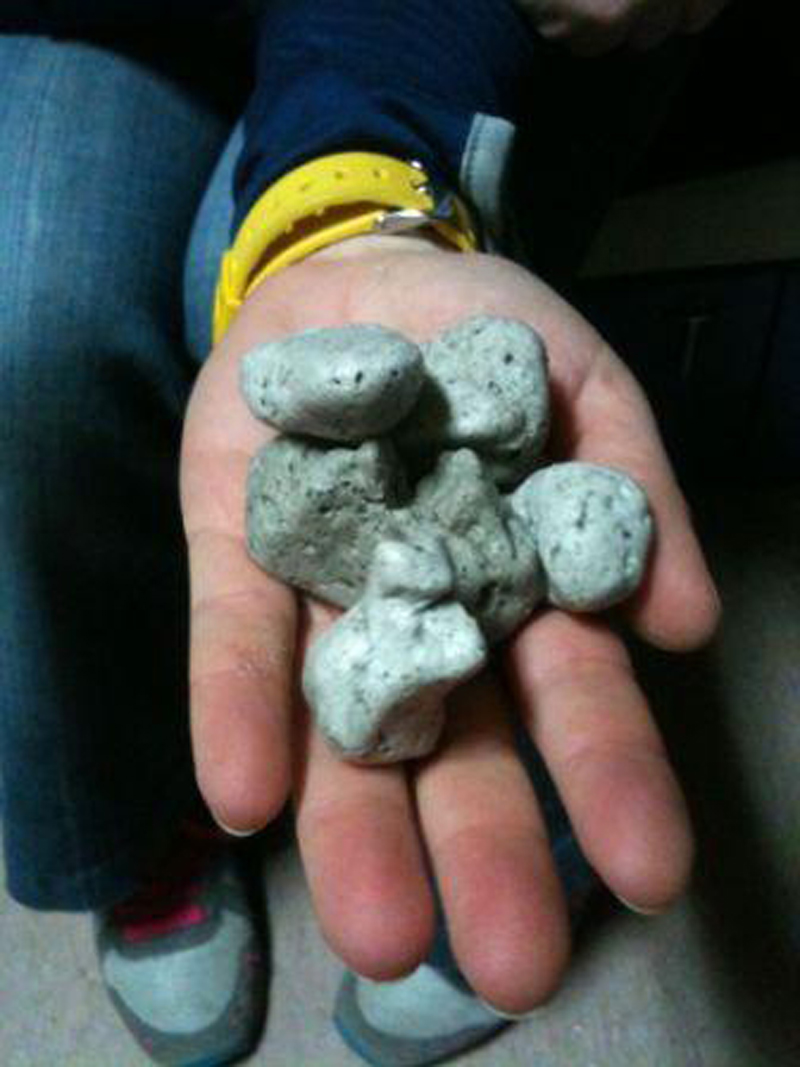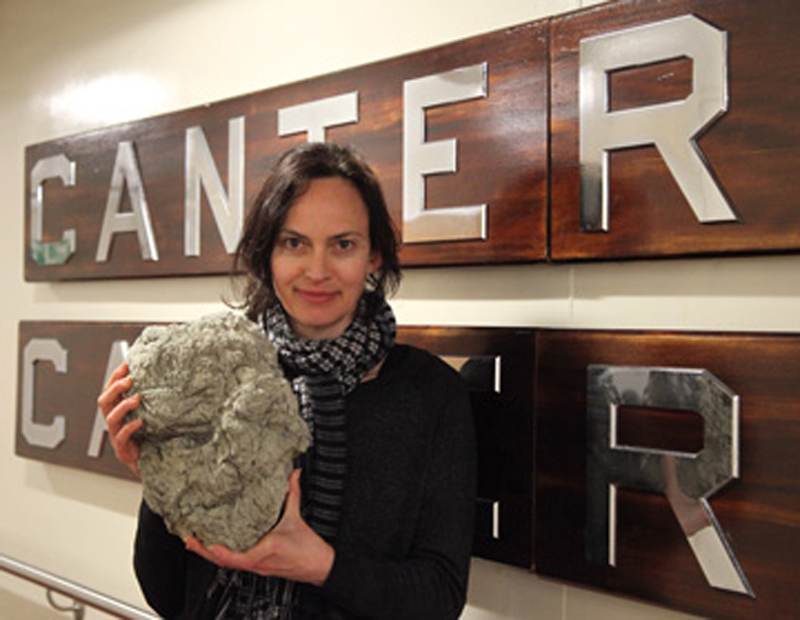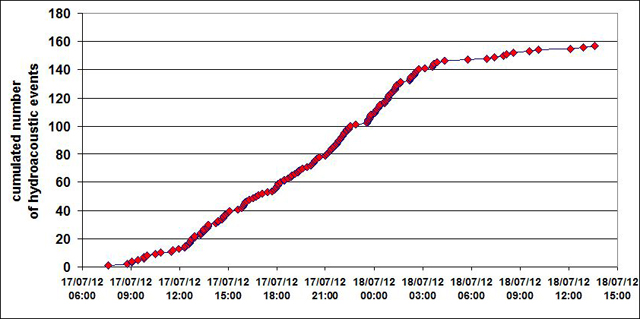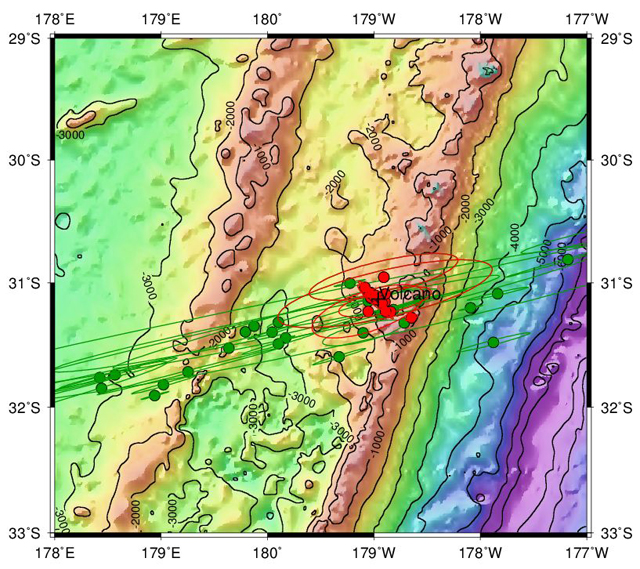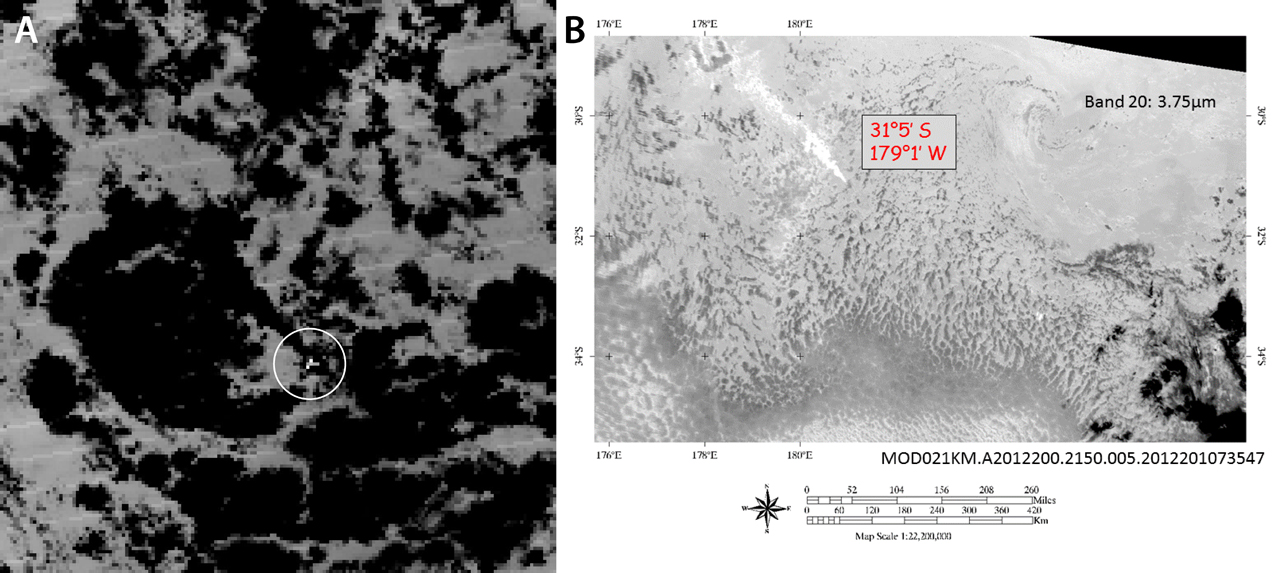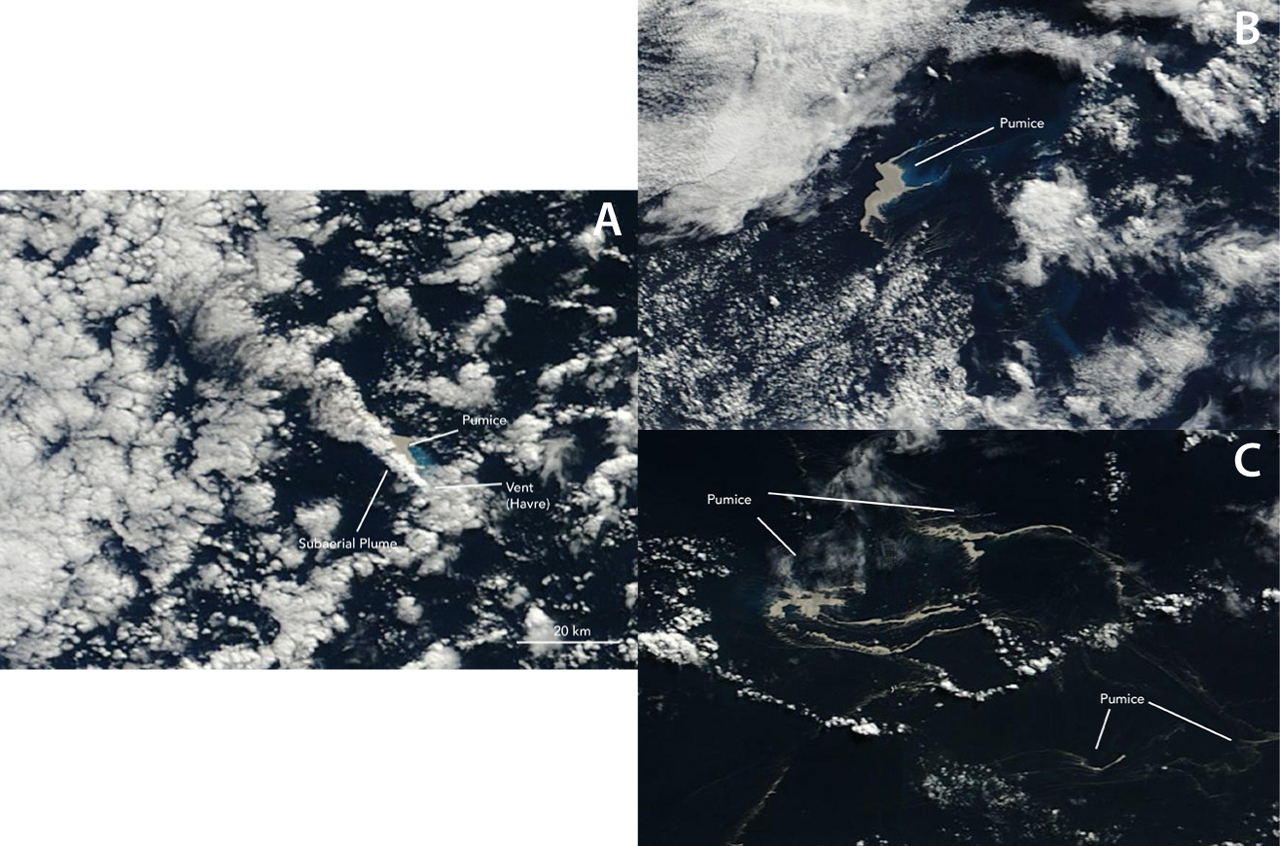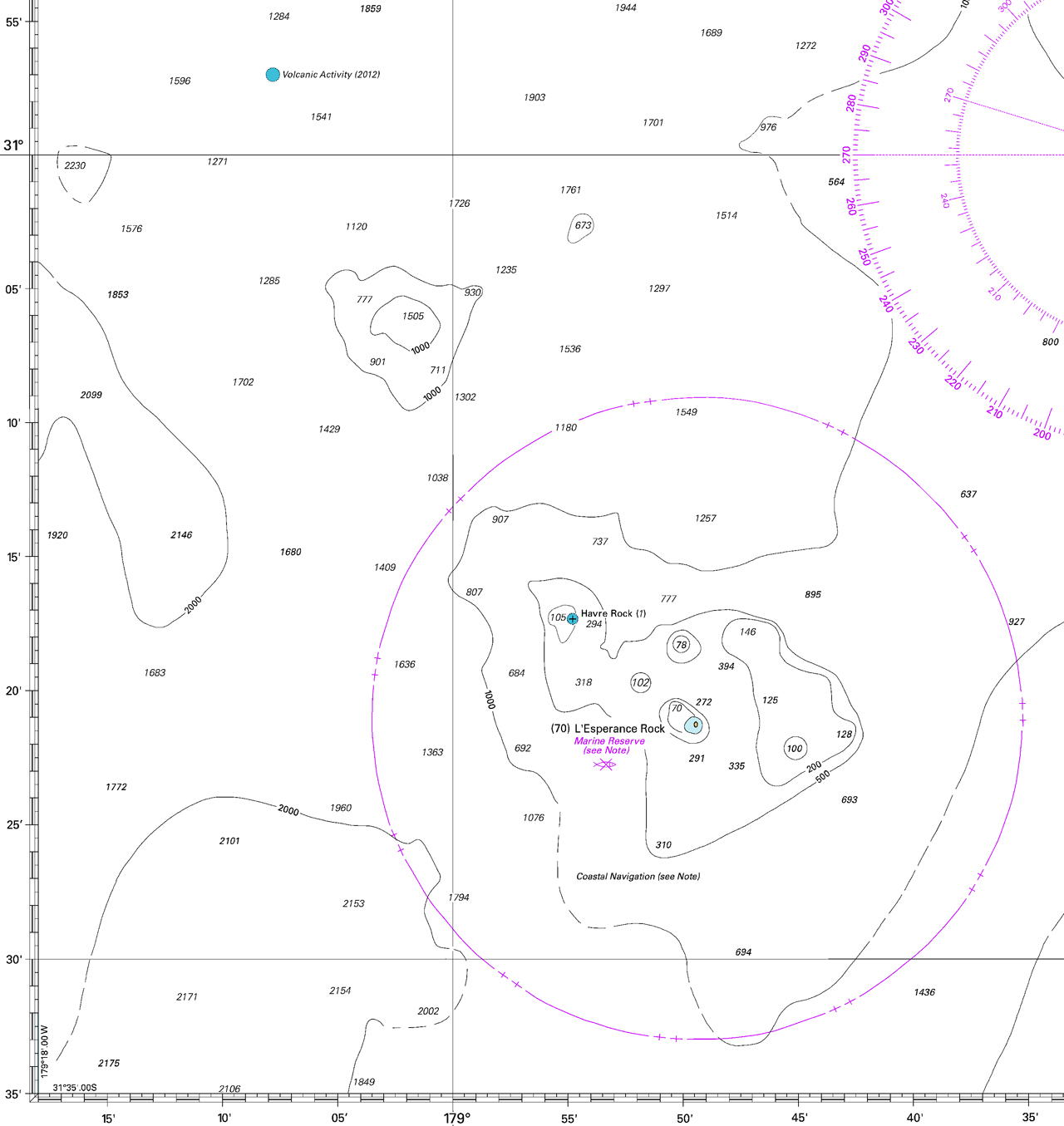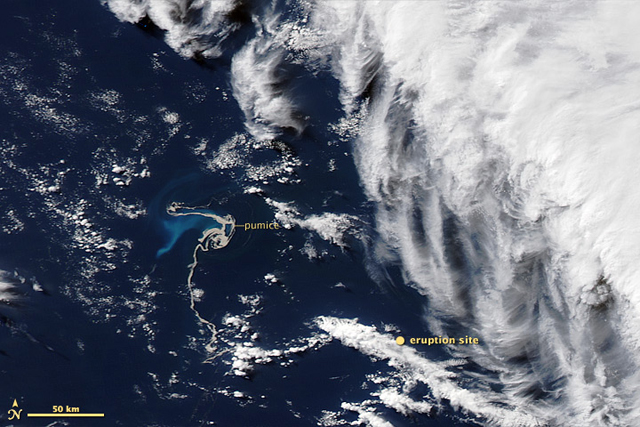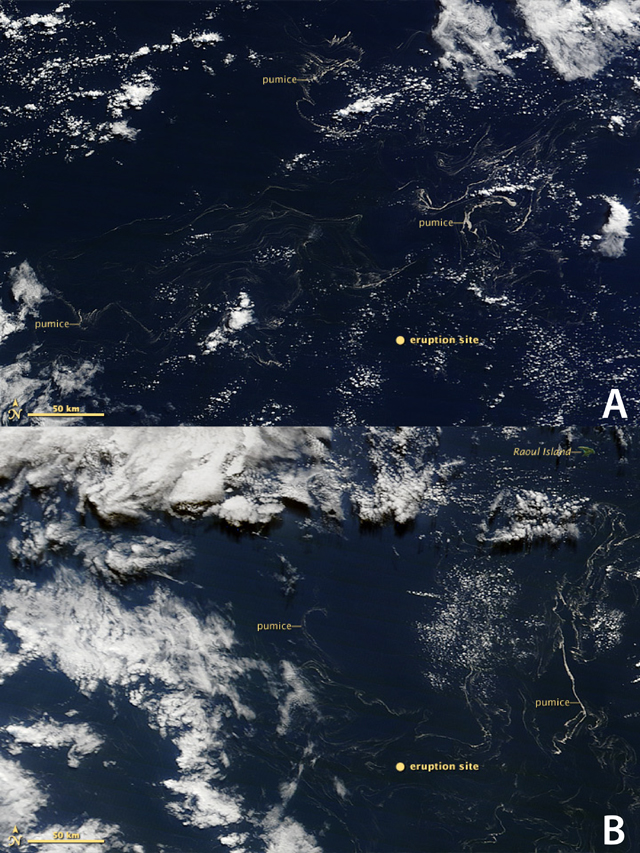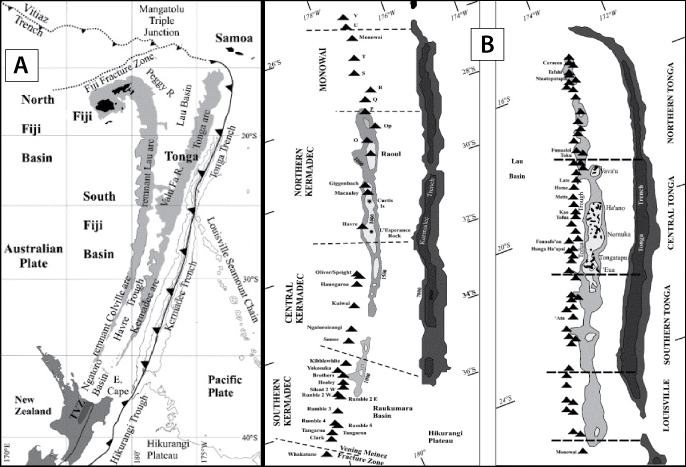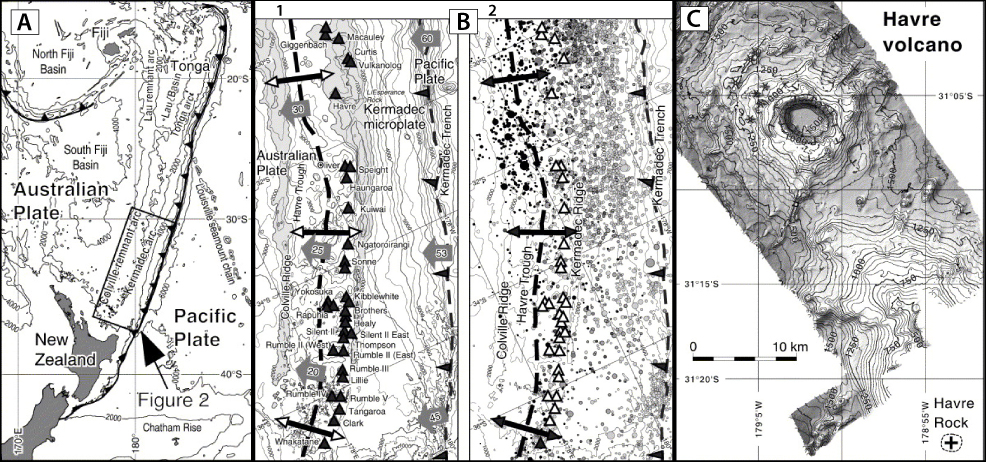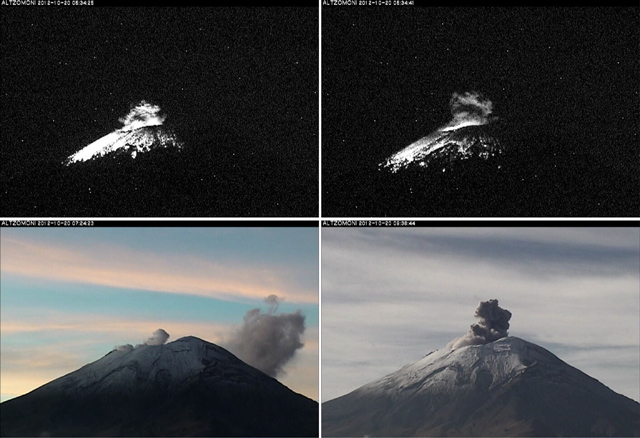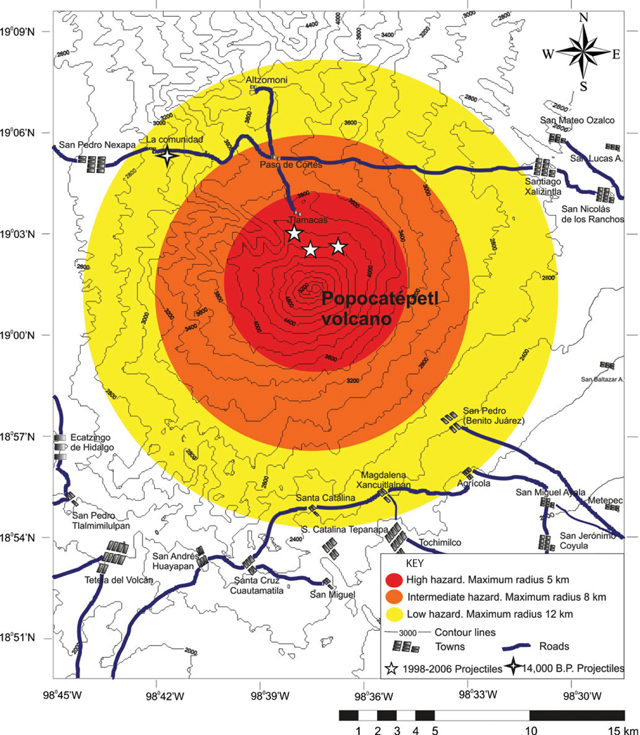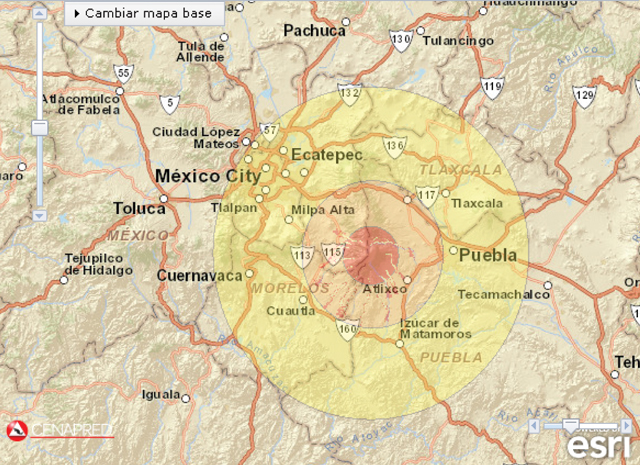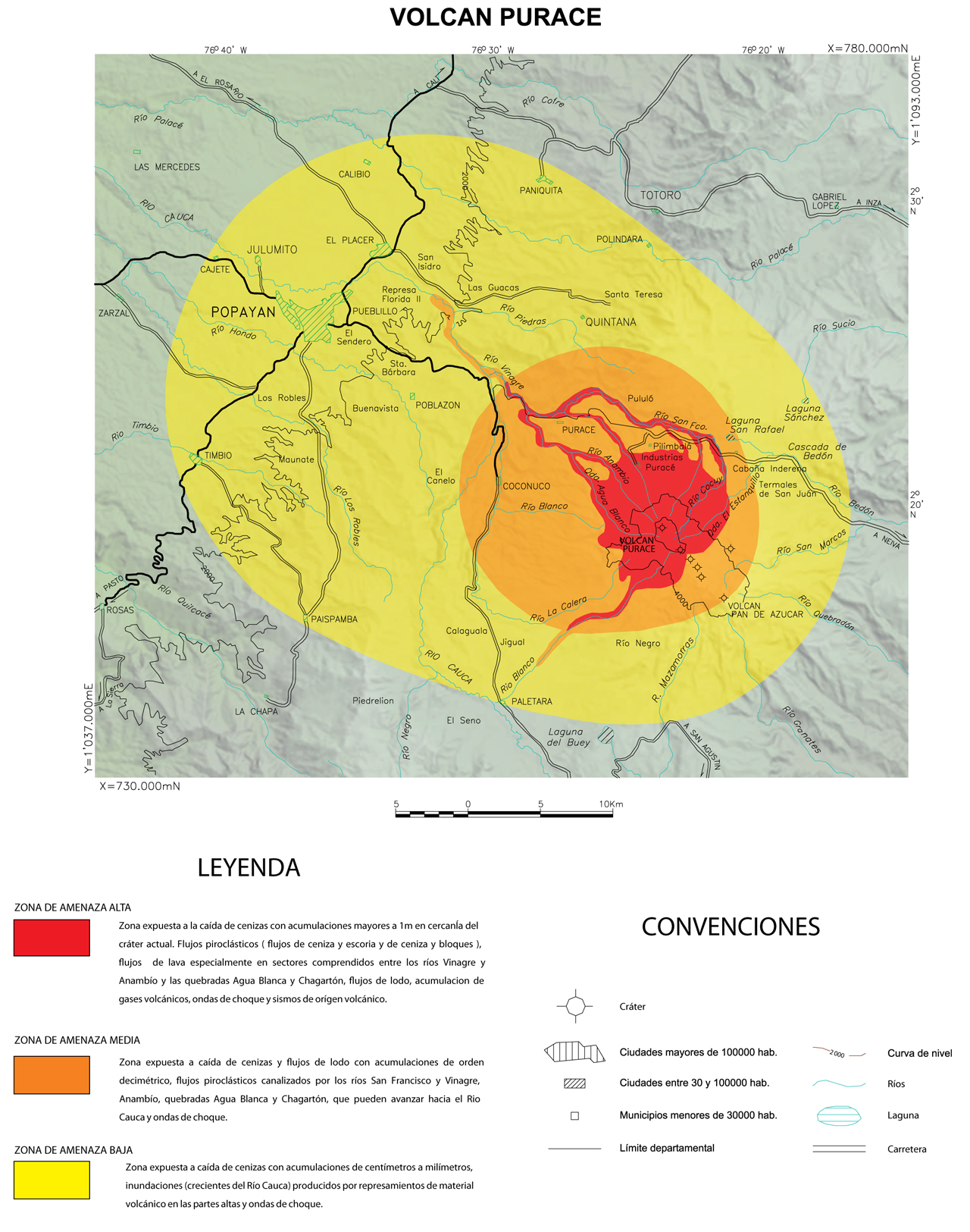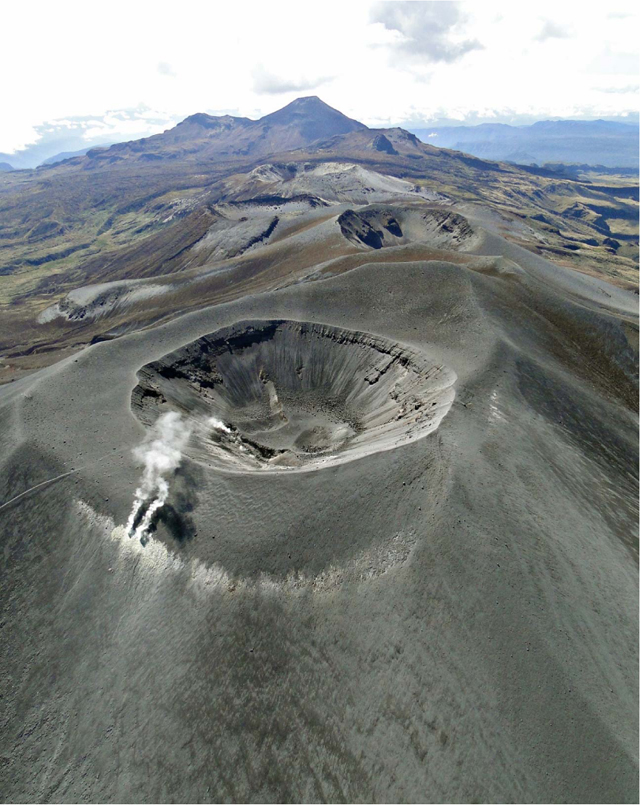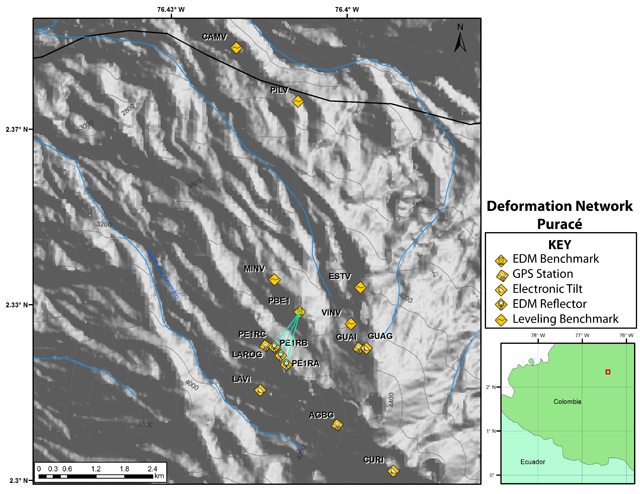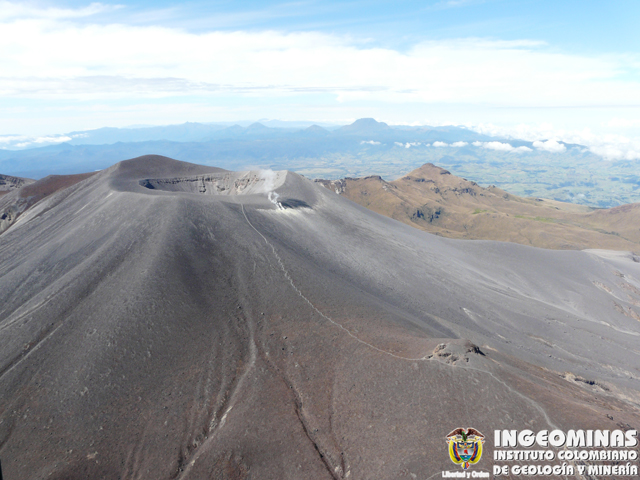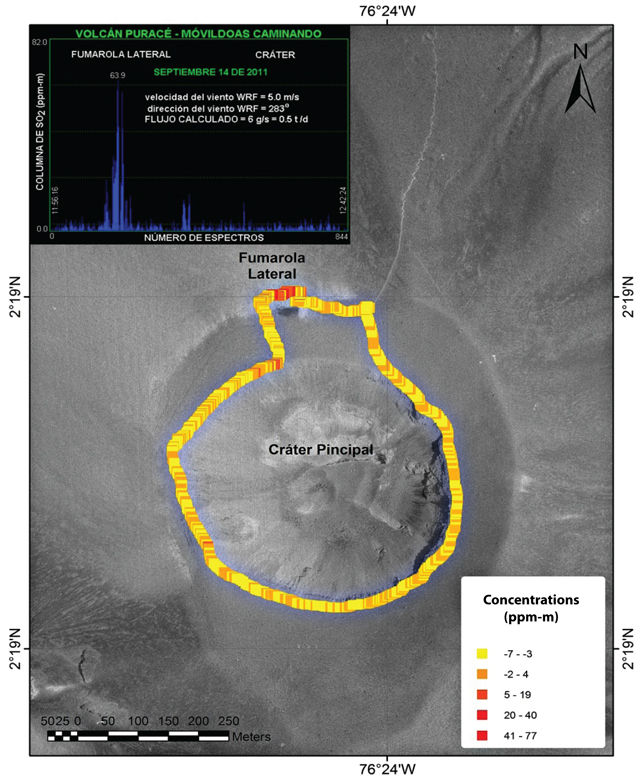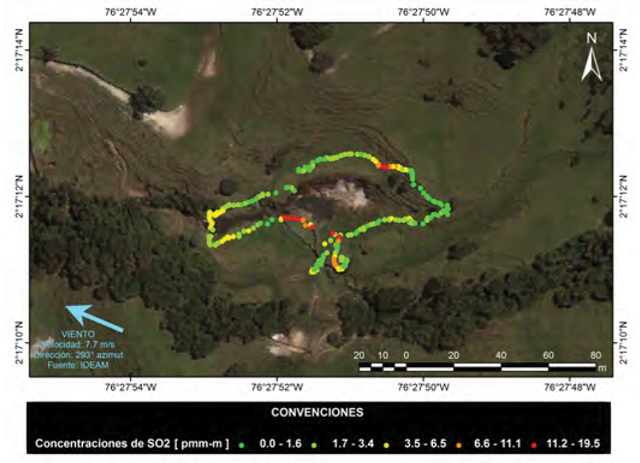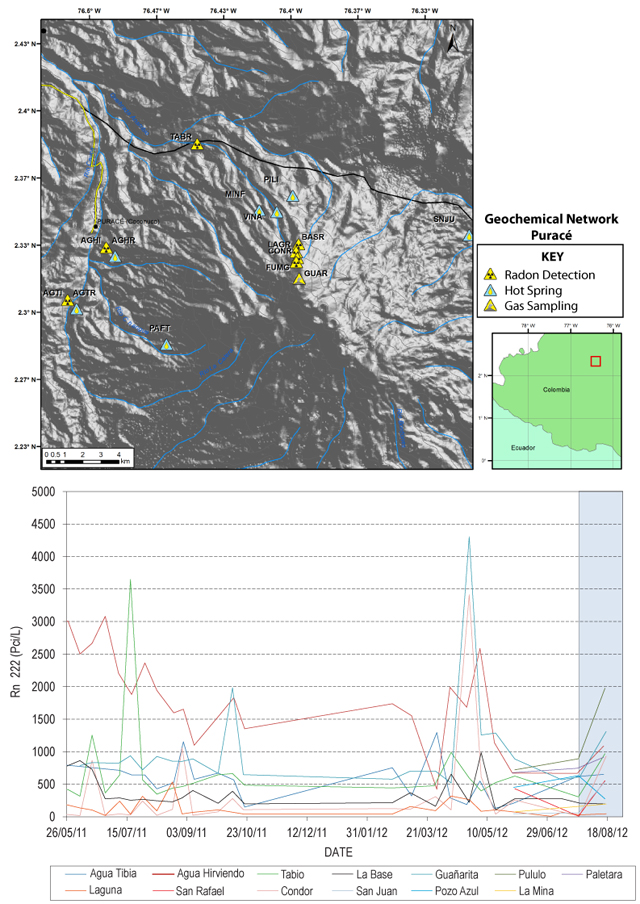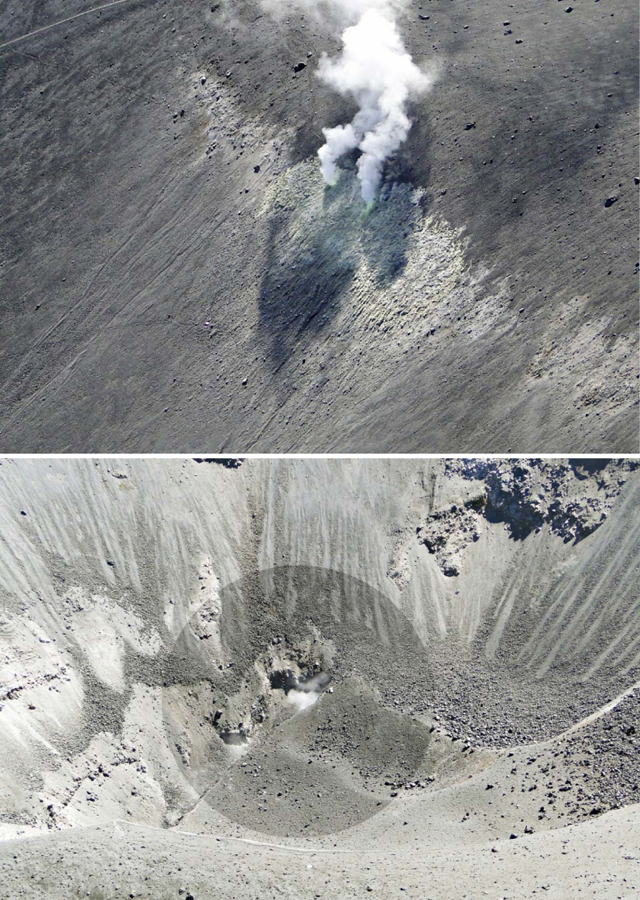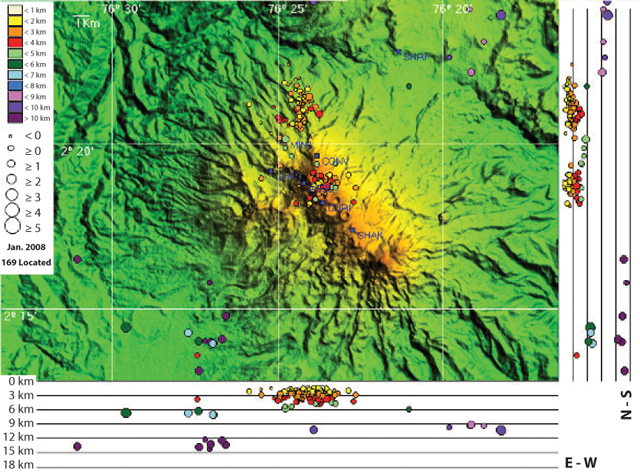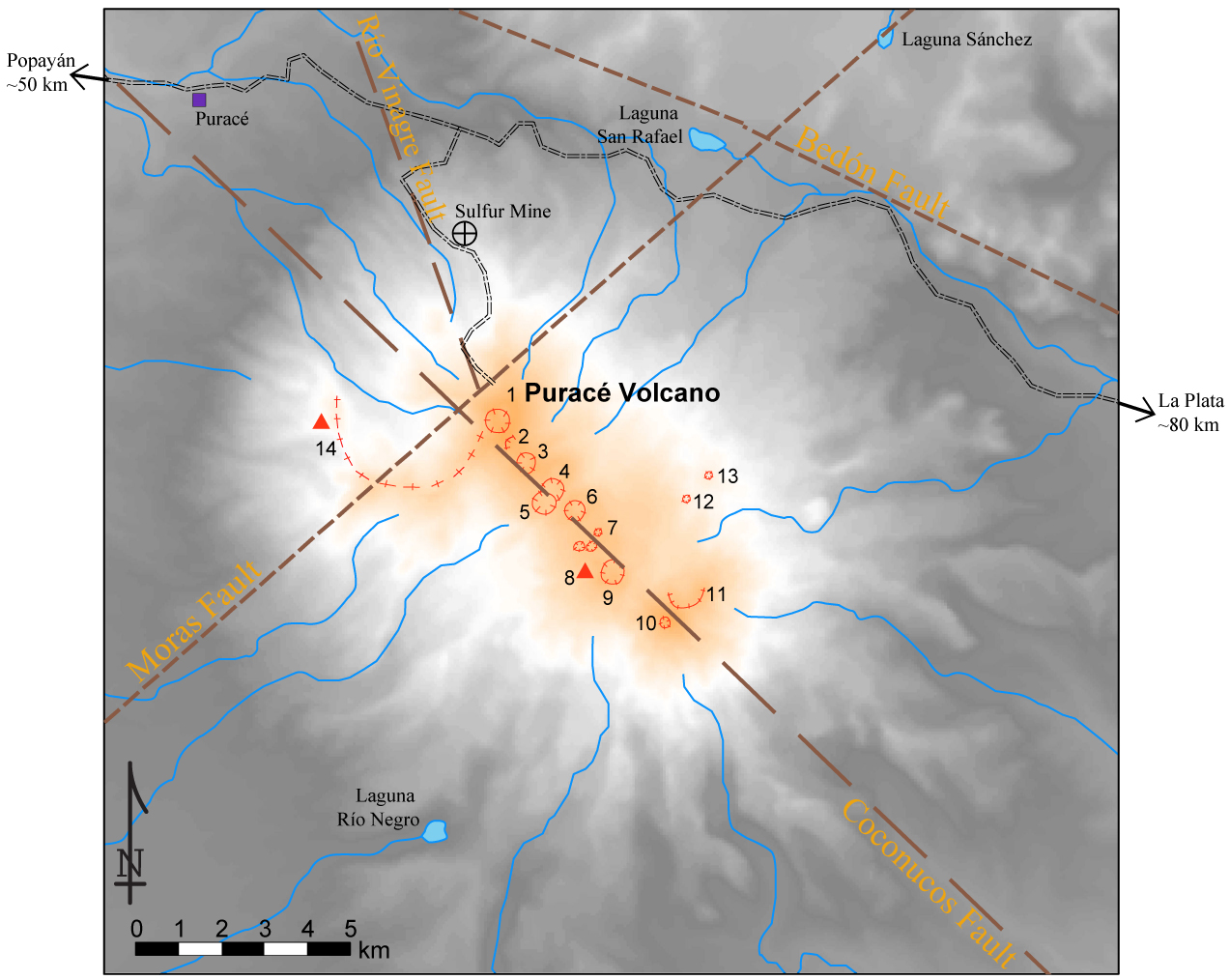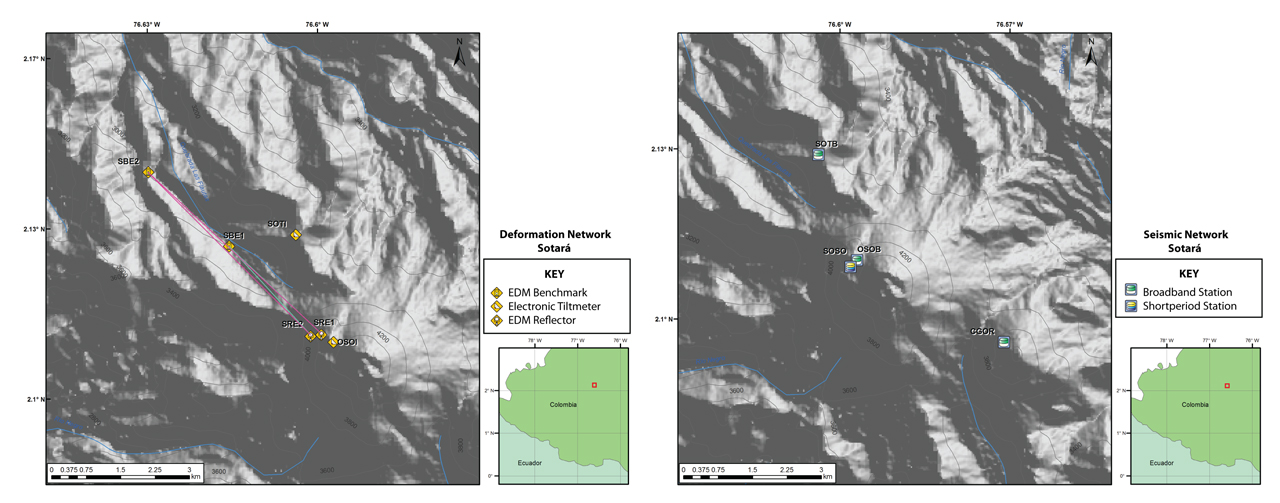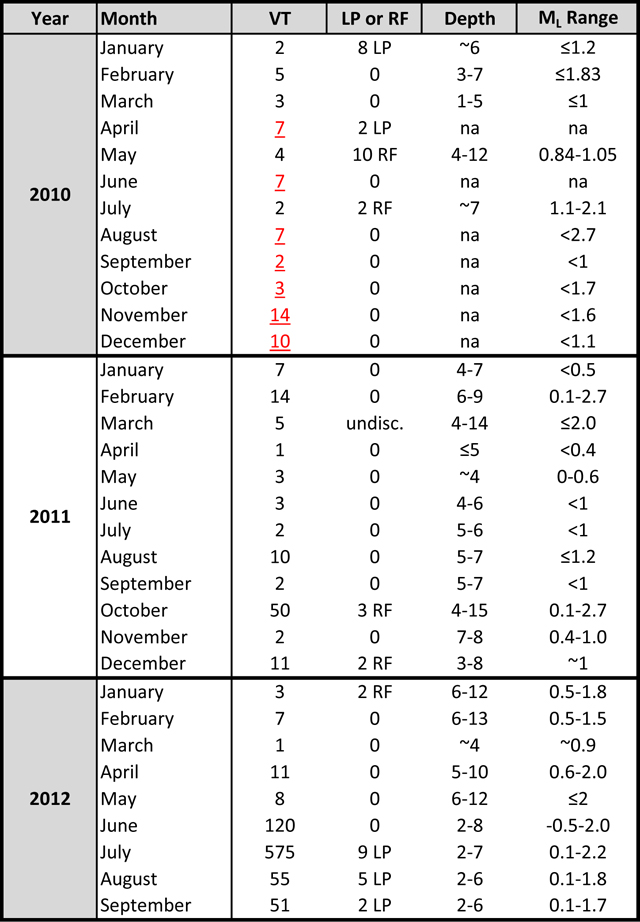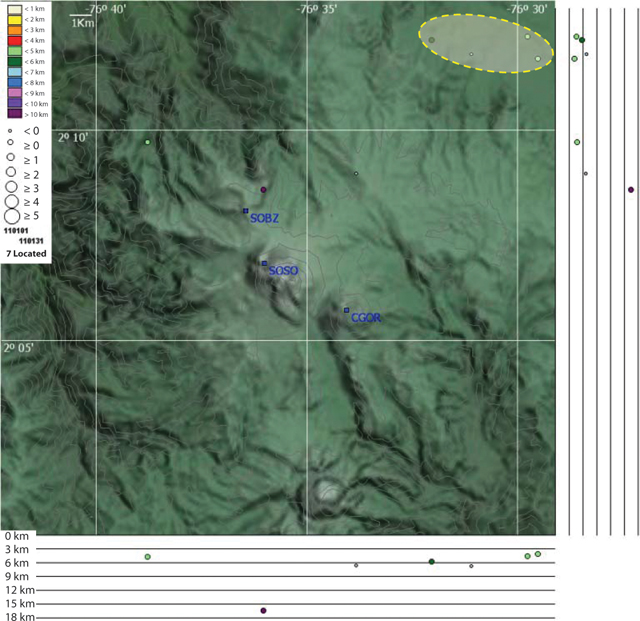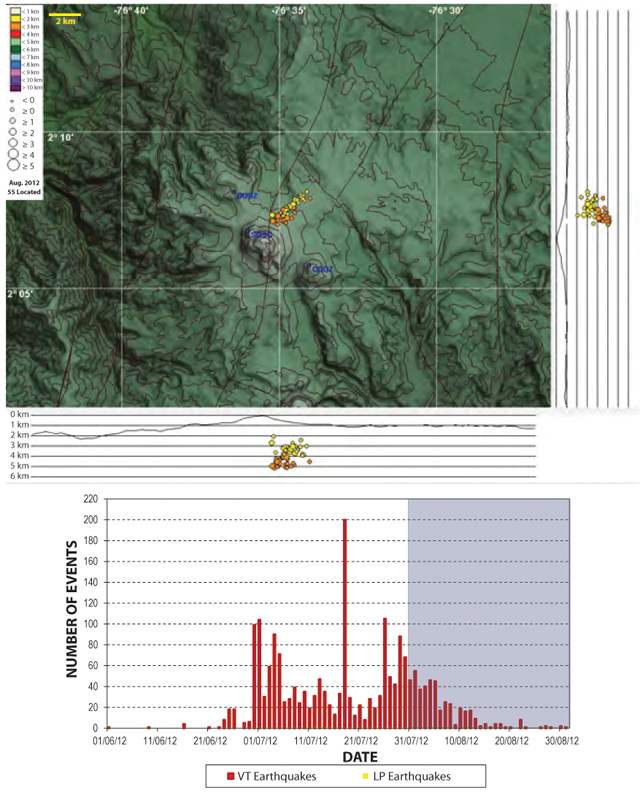Recently Published Bulletin Reports
Erebus (Antarctica) Lava lake remains active; most thermal alerts recorded since 2019
Rincon de la Vieja (Costa Rica) Frequent phreatic explosions during July-December 2023
Bezymianny (Russia) Explosion on 18 October 2023 sends ash plume 8 km high; lava flows and incandescent avalanches
Kilauea (United States) Low-level lava effusions in the lava lake at Halema’uma’u during July-December 2022
Nyamulagira (DR Congo) Lava flows and thermal activity during May-October 2023
Bagana (Papua New Guinea) Explosions, ash plumes, ashfall, and lava flows during April-September 2023
Mayon (Philippines) Lava flows, pyroclastic flows, ash emissions, and seismicity during April-September 2023
Nishinoshima (Japan) Eruption plumes and gas-and-steam plumes during May-August 2023
Krakatau (Indonesia) White gas-and-steam plumes and occasional ash plumes during May-August 2023
Villarrica (Chile) Strombolian activity, gas-and-ash emissions, and crater incandescence during April-September 2023
Merapi (Indonesia) Frequent incandescent avalanches during April-September 2023
Ebeko (Russia) Moderate explosive activity with ash plumes continued during June-November 2023
Erebus (Antarctica) — January 2024  Cite this Report
Cite this Report
Erebus
Antarctica
77.53°S, 167.17°E; summit elev. 3794 m
All times are local (unless otherwise noted)
Lava lake remains active; most thermal alerts recorded since 2019
The lava lake in the summit crater of Erebus has been active since at least 1972. Located in Antarctica overlooking the McMurdo Station on Ross Island, it is the southernmost active volcano on the planet. Because of the remote location, activity is primarily monitored by satellites. This report covers activity during 2023.
The number of thermal alerts recorded by the Hawai'i Institute of Geophysics and Planetology’s MODVOLC Thermal Alerts System increased considerably in 2023 compared to the years 2020-2022 (table 9). In contrast to previous years, the MODIS instruments aboard the Aqua and Terra satellites captured data from Erebus every month during 2023. Consistent with previous years, the lowest number of anomalous pixels were recorded in January, November, and December.
Table 9. Number of monthly MODIS-MODVOLC thermal alert pixels recorded at Erebus during 2017-2023. See BGVN 42:06 for data from 2000 through 2016. The table was compiled using data provided by the HIGP – MODVOLC Thermal Alerts System.
| Year |
Jan |
Feb |
Mar |
Apr |
May |
Jun |
Jul |
Aug |
Sep |
Oct |
Nov |
Dec |
SUM |
| 2017 |
0 |
21 |
9 |
0 |
0 |
1 |
11 |
61 |
76 |
52 |
0 |
3 |
234 |
| 2018 |
0 |
21 |
58 |
182 |
55 |
17 |
137 |
172 |
103 |
29 |
0 |
0 |
774 |
| 2019 |
2 |
21 |
162 |
151 |
55 |
56 |
75 |
53 |
29 |
19 |
1 |
0 |
624 |
| 2020 |
0 |
2 |
16 |
18 |
4 |
4 |
1 |
3 |
18 |
3 |
1 |
6 |
76 |
| 2021 |
0 |
9 |
1 |
0 |
2 |
56 |
46 |
47 |
35 |
52 |
5 |
3 |
256 |
| 2022 |
1 |
13 |
55 |
22 |
15 |
32 |
39 |
19 |
31 |
11 |
0 |
0 |
238 |
| 2023 |
2 |
33 |
49 |
82 |
41 |
32 |
70 |
64 |
42 |
17 |
5 |
11 |
448 |
Sentinel-2 infrared images showed one or two prominent heat sources within the summit crater, accompanied by adjacent smaller sources, similar to recent years (see BGVN 46:01, 47:02, and 48:01). A unique image was obtained on 25 November 2023 by the OLI-2 (Operational Land Imager-2) on Landsat 9, showing the upper part of the volcano surrounded by clouds (figure 32).
Geologic Background. Mount Erebus, the world's southernmost historically active volcano, overlooks the McMurdo research station on Ross Island. It is the largest of three major volcanoes forming the crudely triangular Ross Island. The summit of the dominantly phonolitic volcano has been modified by one or two generations of caldera formation. A summit plateau at about 3,200 m elevation marks the rim of the youngest caldera, which formed during the late-Pleistocene and within which the modern cone was constructed. An elliptical 500 x 600 m wide, 110-m-deep crater truncates the summit and contains an active lava lake within a 250-m-wide, 100-m-deep inner crater; other lava lakes are sometimes present. The glacier-covered volcano was erupting when first sighted by Captain James Ross in 1841. Continuous lava-lake activity with minor explosions, punctuated by occasional larger Strombolian explosions that eject bombs onto the crater rim, has been documented since 1972, but has probably been occurring for much of the volcano's recent history.
Information Contacts: Hawai'i Institute of Geophysics and Planetology (HIGP) - MODVOLC Thermal Alerts System, School of Ocean and Earth Science and Technology (SOEST), Univ. of Hawai'i, 2525 Correa Road, Honolulu, HI 96822, USA (URL: http://modis.higp.hawaii.edu/); Copernicus Browser, Copernicus Data Space Ecosystem, European Space Agency (URL: https://dataspace.copernicus.eu/browser/); NASA Earth Observatory, EOS Project Science Office, NASA Goddard Space Flight Center, Goddard, Maryland, USA (URL: https://earthobservatory.nasa.gov/images/152134/erebus-breaks-through).
Rincon de la Vieja (Costa Rica) — January 2024  Cite this Report
Cite this Report
Rincon de la Vieja
Costa Rica
10.83°N, 85.324°W; summit elev. 1916 m
All times are local (unless otherwise noted)
Frequent phreatic explosions during July-December 2023
Rincón de la Vieja is a volcanic complex in Costa Rica with a hot convecting acid lake that exhibits frequent weak phreatic explosions, gas-and-steam emissions, and occasional elevated sulfur dioxide levels (BGVN 45:10, 46:03, 46:11). The current eruption period began June 2021. This report covers activity during July-December 2023 and is based on weekly bulletins and occasional daily reports from the Observatorio Vulcanologico Sismologica de Costa Rica-Universidad Nacional (OVSICORI-UNA).
Numerous weak phreatic explosions continued during July-December 2023, along with gas-and-steam emissions and plumes that rose as high as 3 km above the crater rim. Many weekly OVSICORI-UNA bulletins included the previous week's number of explosions and emissions (table 9). For many explosions, the time of explosion was given (table 10). Frequent seismic activity (long-period earthquakes, volcano-tectonic earthquakes, and tremor) accompanied the phreatic activity.
Table 9. Number of reported weekly phreatic explosions and gas-and-steam emissions at Rincón de la Vieja, July-December 2023. Counts are reported for the week before the Weekly Bulletin date; not all reports included these data. Courtesy of OVSICORI-UNA.
| OVSICORI Weekly Bulletin |
Number of explosions |
Number of emissions |
| 28 Jul 2023 |
6 |
14 |
| 4 Aug 2023 |
10 |
12 |
| 1 Sep 2023 |
13 |
11 |
| 22 Sep 2023 |
12 |
13 |
| 29 Sep 2023 |
6 |
11 |
| 6 Oct 2023 |
12 |
5 |
| 13 Oct 2023 |
7 |
9 |
| 20 Oct 2023 |
1 |
15 |
| 27 Oct 2023 |
3 |
23 |
| 3 Nov 2023 |
3 |
10 |
| 17 Nov 2023 |
0 |
Some |
| 24 Nov 2023 |
0 |
14 |
| 8 Dec 2023 |
4 |
16 |
| 22 Dec 2023 |
8 |
18 |
Table 10. Summary of activity at Rincón de la Vieja during July-December 2023. Weak phreatic explosions and gas emissions are noted where the time of explosion was indicated in the weekly or daily bulletins. Height of plumes or emissions are distance above the crater rim. Courtesy of OVSICORI-UNA.
| Date |
Time |
Description of Activity |
| 1 Jul 2023 |
0156 |
Explosion. |
| 2 Jul 2023 |
0305 |
Explosion. |
| 4 Jul 2023 |
0229, 0635 |
Event at 0635 produced a gas-and-steam plume that rose 700 m and drifted W; seen by residents in Liberia (21 km SW). |
| 9 Jul 2023 |
1843 |
Explosion. |
| 21 Jul 2023 |
0705 |
Explosion. |
| 26 Jul 2023 |
1807 |
Explosion. |
| 28 Jul 2023 |
0802 |
Explosion generated a gas-and-steam plume that rose 500 m. |
| 30 Jul 2023 |
1250 |
Explosion. |
| 31 Jul 2023 |
2136 |
Explosion. |
| 11 Aug 2023 |
0828 |
Explosion. |
| 18 Aug 2023 |
1304 |
Explosion. |
| 21 Aug 2023 |
1224 |
Explosion generated gas-and-steam plumes rose 500-600 m. |
| 22 Aug 2023 |
0749 |
Explosion generated gas-and-steam plumes rose 500-600 m. |
| 24 Aug 2023 |
1900 |
Explosion. |
| 25 Aug 2023 |
0828 |
Event produced a steam-and-gas plume that rose 3 km and drifted NW. |
| 27-28 Aug 2023 |
0813 |
Four small events; the event at 0813 on 28 August lasted two minutes and generated a steam-and-gas plume that rose 2.5 km. |
| 1 Sep 2023 |
1526 |
Explosion generated plume that rose 2 km and ejected material onto the flanks. |
| 2-3 Sep 2023 |
- |
Small explosions detected in infrasound data. |
| 4 Sep 2023 |
1251 |
Gas-and-steam plume rose 1 km and drifted W. |
| 7 Nov 2023 |
1113 |
Explosion. |
| 8 Nov 2023 |
0722 |
Explosion. |
| 12 Nov 2023 |
0136 |
Small gas emissions. |
| 14 Nov 2023 |
0415 |
Small gas emissions. |
According to OVSICORI-UNA, during July-October the average weekly sulfur dioxide (SO2) flux ranged from 68 to 240 tonnes/day. However, in mid-November the flux increased to as high as 334 tonnes/day, the highest value measured in recent years. The high SO2 flux in mid-November was also detected by the TROPOMI instrument on the Sentinel-5P satellite (figure 43).
Geologic Background. Rincón de la Vieja, the largest volcano in NW Costa Rica, is a remote volcanic complex in the Guanacaste Range. The volcano consists of an elongated, arcuate NW-SE-trending ridge constructed within the 15-km-wide early Pleistocene Guachipelín caldera, whose rim is exposed on the south side. Sometimes known as the "Colossus of Guanacaste," it has an estimated volume of 130 km3 and contains at least nine major eruptive centers. Activity has migrated to the SE, where the youngest-looking craters are located. The twin cone of Santa María volcano, the highest peak of the complex, is located at the eastern end of a smaller, 5-km-wide caldera and has a 500-m-wide crater. A Plinian eruption producing the 0.25 km3 Río Blanca tephra about 3,500 years ago was the last major magmatic eruption. All subsequent eruptions, including numerous historical eruptions possibly dating back to the 16th century, have been from the prominent active crater containing a 500-m-wide acid lake located ENE of Von Seebach crater.
Information Contacts: Observatorio Vulcanológico Sismológica de Costa Rica-Universidad Nacional (OVSICORI-UNA), Apartado 86-3000, Heredia, Costa Rica (URL: http://www.ovsicori.una.ac.cr/); NASA Global Sulfur Dioxide Monitoring Page, Atmospheric Chemistry and Dynamics Laboratory, NASA Goddard Space Flight Center (NASA/GSFC), 8800 Greenbelt Road, Goddard MD 20771, USA (URL: https://so2.gsfc.nasa.gov/).
Bezymianny (Russia) — November 2023  Cite this Report
Cite this Report
Bezymianny
Russia
55.972°N, 160.595°E; summit elev. 2882 m
All times are local (unless otherwise noted)
Explosion on 18 October 2023 sends ash plume 8 km high; lava flows and incandescent avalanches
Bezymianny, located on Russia’s Kamchatka Peninsula, has had eruptions since 1955 characterized by dome growth, explosions, pyroclastic flows, ash plumes, and ashfall. Activity during November 2022-April 2023 included gas-and-steam emissions, lava dome collapses generating avalanches, and persistent thermal activity. Similar eruptive activity continued from May through October 2023, described here based on information from weekly and daily reports of the Kamchatka Volcano Eruptions Response Team (KVERT), notices from Tokyo VAAC (Volcanic Ash Advisory Center), and from satellite data.
Overall activity decreased after the strong period of activity in late March through April 2023, which included ash explosions during 29 March and 7-8 April 2023 that sent plumes as high as 10-12 km altitude, along with dome growth and lava flows (BGVN 48:05). This reduced activity can be seen in the MIROVA thermal detection system graph (figure 56), which was consistent with data from the MODVOLC thermal detection system and with Sentinel-2 satellite images that showed persistent hotspots in the summit crater when conditions allowed observations. A renewed period of strong activity began in mid-October 2023.
Activity increased significantly on 17 October 2023 when large collapses began during 0700-0830 on the E flanks of the lava dome and continued to after 0930 the next day (figure 57). Ash plumes rose to an altitude of 4.5-5 km, extending 220 km NNE by 18 October. A large explosion at 1630 on 18 October produced an ash plume that rose to an altitude of 11 km (8 km above the summit) and drifted NNE and then NW, extending 900 km NW within two days at an altitude of 8 km. Minor ashfall was noted in Kozyrevsk (45 km WNW). At 0820 on 20 October an ash plume was identified in satellite images drifting 100 km ENE at altitudes of 4-4.5 km.
Lava flows and hot avalanches from the dome down the SE flank continued over the next few days, including 23 October when clear conditions allowed good observations (figures 58 and 59). A large thermal anomaly was observed over the volcano through 24 October, and in the summit crater on 30 October (figure 60). Strong fumarolic activity continued, with numerous avalanches and occasional incandescence. By the last week of October, volcanic activity had decreased to a level consistent with that earlier in the reporting period.
Aviation warnings were frequently updated during 17-20 October. KVERT issued a Volcano Observatory Notice for Aviation (VONA) on 17 October at 1419 and 1727 (0219 and 0527 UTC) raising the Aviation Color Code (ACC) from Yellow to Orange (second highest level). The next day, KVERT issued a VONA at 1705 (0505 UTC) raising the ACC to Red (highest level) but lowered it back to Orange at 2117 (0917 UTC). After another decrease to Yellow and back to Orange, the ACC was reduced to Yellow on 20 October at 1204 (0004 UTC). In addition, the Tokyo VAAC issued a series of Volcanic Ash Advisories beginning on 16 October and continuing through 30 October.
Geologic Background. The modern Bezymianny, much smaller than its massive neighbors Kamen and Kliuchevskoi on the Kamchatka Peninsula, was formed about 4,700 years ago over a late-Pleistocene lava-dome complex and an edifice built about 11,000-7,000 years ago. Three periods of intensified activity have occurred during the past 3,000 years. The latest period, which was preceded by a 1,000-year quiescence, began with the dramatic 1955-56 eruption. This eruption, similar to that of St. Helens in 1980, produced a large open crater that was formed by collapse of the summit and an associated lateral blast. Subsequent episodic but ongoing lava-dome growth, accompanied by intermittent explosive activity and pyroclastic flows, has largely filled the 1956 crater.
Information Contacts: Kamchatka Volcanic Eruptions Response Team (KVERT), Far Eastern Branch, Russian Academy of Sciences, 9 Piip Blvd., Petropavlovsk-Kamchatsky, 683006, Russia (URL: http://www.kscnet.ru/ivs/kvert/); Kamchatka Volcanological Station, Kamchatka Branch of Geophysical Survey, (KB GS RAS), Klyuchi, Kamchatka Krai, Russia (URL: http://volkstat.ru/); Tokyo Volcanic Ash Advisory Center (VAAC), 1-3-4 Otemachi, Chiyoda-ku, Tokyo 100-8122, Japan (URL: http://ds.data.jma.go.jp/svd/vaac/data/); Hawai'i Institute of Geophysics and Planetology (HIGP) - MODVOLC Thermal Alerts System, School of Ocean and Earth Science and Technology (SOEST), Univ. of Hawai'i, 2525 Correa Road, Honolulu, HI 96822, USA (URL: http://modis.higp.hawaii.edu/); MIROVA (Middle InfraRed Observation of Volcanic Activity), a collaborative project between the Universities of Turin and Florence (Italy) supported by the Centre for Volcanic Risk of the Italian Civil Protection Department (URL: http://www.mirovaweb.it/); Copernicus Browser, Copernicus Data Space Ecosystem, European Space Agency (URL: https://dataspace.copernicus.eu/browser/).chr
Kilauea (United States) — January 2023  Cite this Report
Cite this Report
Kilauea
United States
19.421°N, 155.287°W; summit elev. 1222 m
All times are local (unless otherwise noted)
Low-level lava effusions in the lava lake at Halema’uma’u during July-December 2022
Kīlauea is the southeastern-most volcano in Hawaii and overlaps the E flank of the Mauna Loa volcano. Its East Rift Zone (ERZ) has been intermittently active for at least 2,000 years. An extended eruption period began in January 1983 and was characterized by open lava lakes and lava flows from the summit caldera and the East Rift Zone. During May 2018 magma migrated into the Lower East Rift Zone (LERZ) and opened 24 fissures along a 6-km-long NE-trending fracture zone that produced lava flows traveling in multiple directions. As lava emerged from the fissures, the lava lake at Halema'uma'u drained and explosions sent ash plumes to several kilometers altitude (BGVN 43:10).
The current eruption period started during September 2021 and has recently been characterized by lava effusions, spatter, and sulfur dioxide emissions in the active Halema’uma’u lava lake (BGVN 47:08). Lava effusions, some spatter, and sulfur dioxide emissions have continued during this reporting period of July through December 2022 using daily reports, volcanic activity notices, and abundant photo, map, and video data from the US Geological Survey's (USGS) Hawaiian Volcano Observatory (HVO).
Summary of activity during July-December 2022. Low-level effusions have continued at the western vent of the Halema’uma’u crater during July through early December 2022. Occasional weak ooze-outs (also called lava break outs) would occur along the margins of the crater floor. The overall level of the active lava lake throughout the reporting period gradually increased due to infilling, however it stagnated in mid-September (table 13). During September through November, activity began to decline, though lava effusions persisted at the western vent. By 9 December, the active part of the lava lake had completely crusted over, and incandescence was no longer visible.
Table 13. Summary of measurements taken during overflights at Kīlauea that show a gradual increase in the active lava lake level and the volume of lava effused since 29 September 2021. Lower activity was reported during September-October. Data collected during July-December 2022. Courtesy of HVO.
| Date: |
Level of the active lava lake (m): |
Cumulative volume of lava effused (million cubic meters): |
| 7 Jul 2022 |
130 |
95 |
| 19 Jul 2022 |
133 |
98 |
| 4 Aug 2022 |
136 |
102 |
| 16 Aug 2022 |
137 |
104 |
| 12 Sep 2022 |
143 |
111 |
| 5 Oct 2022 |
143 |
111 |
| 28 Oct 2022 |
143 |
111 |
Activity during July 2022. Lava effusions were reported from the western vent in the Halema’uma’u crater, along with occasional weak ooze-outs along the margins of the crater floor. The height of the lava lake was variable due to deflation-inflation tilt events; for example, the lake level dropped approximately 3-4 m during a summit deflation-inflation event reported on 1 July. Webcam images taken during the night of 6-12 July showed intermittent low-level spattering at the western vent that rose less than 10 m above the vent (figure 519). Measurements made during an overflight on 7 July indicated that the crater floor was infilled about 130 m and that 95 million cubic meters of lava had been effused since 29 September 2021. A single, relatively small lava ooze-out was active to the S of the lava lake. Around midnight on 8 July there were two brief periods of lava overflow onto the lake margins. On 9 July lava ooze-outs were reported near the SE and NE edges of the crater floor and during 10-11 July they occurred near the E, NE, and NW edges. On 16 July crater incandescence was reported, though the ooze-outs and spattering were not visible. On 18 July overnight webcam images showed incandescence in the western vent complex and two ooze-outs were reported around 0000 and 0200 on 19 July. By 0900 there were active ooze-outs along the SW edge of the crater floor. Measurements made from an overflight on 19 July indicated that the crater floor was infilled about 133 m and 98 million cubic meters of lava had erupted since 29 September 2021 (figure 520). On 20 July around 1600 active ooze-outs were visible along the N edge of the crater, which continued through the next day. Extensive ooze-outs occurred along the W margin during 24 July until 1900; on 26 July minor ooze-outs were noted along the N margin. Minor spattering was visible on 29 July along the E margin of the lake. The sulfur dioxide emission rates ranged 650-2,800 tons per day (t/d), the higher of which was measured on 8 July (figure 519).
Activity during August 2022. The eruption continued in the Halema’uma’u crater at the western vent. According to HVO the lava in the active lake remained at the level of the bounding levees. Occasional minor ooze-outs were observed along the margins of the crater floor. Strong nighttime crater incandescence was visible after midnight on 6 August over the western vent cone. During 6-7 August scattered small lava lobes were active along the crater floor and incandescence persisted above the western vent through 9 August. During 7-9 August HVO reported a single lava effusion source was active along the NW margin of the crater floor. Measurements from an overflight on 4 August indicated that the crater floor was infilled about 136 m total and that 102 million cubic meters of lava had been erupted since the start of the eruption. Lava breakouts were reported along the N, NE, E, S, and W margins of the crater during 10-16 August. Another overflight survey conducted on 16 August indicated that the crater floor infilled about 137 m and 104 million cubic meters of lava had been erupted since September 2021. Measured sulfur dioxide emissions rates ranged 1,150-2,450 t/d, the higher of which occurred on 8 August.
Activity during September 2022. During September, lava effusion continued from the western vent into the active lava lake and onto the crater floor. Intermittent minor ooze-outs were reported through the month. A small ooze-out was visible on the W crater floor margin at 0220 on 2 September, which showed decreasing surface activity throughout the day, but remained active through 3 September. On 3 September around 1900 a lava outbreak occurred along the NW margin of the crater floor but had stopped by the evening of 4 September. Field crews monitoring the summit lava lake on 9 September observed spattering on the NE margin of the lake that rose no higher than 10 m, before falling back onto the lava lake crust (figure 521). Overflight measurements on 12 September indicated that the crater floor was infilled a total of 143 m and 111 million cubic meters of lava had been erupted since September 2021. Extensive breakouts in the W and N part of the crater floor were reported at 1600 on 20 September and continued into 26 September. The active part of the lava lake dropped by 10 m while other parts of the crater floor dropped by several meters. Summit tiltmeters recorded a summit seismic swarm of more than 80 earthquakes during 1500-1800 on 21 September, which occurred about 1.5 km below Halema’uma’u; a majority of these were less than Mw 2. By 22 September the active part of the lava lake was infilled about 2 m. On 23 September the western vent areas exhibited several small spatter cones with incandescent openings, along with weak, sporadic spattering (figure 522). The sulfur dioxide emission rate ranged from 930 t/d to 2,000 t/d, the higher of which was measured on 6 September.
Activity during October 2022. Activity during October declined slightly compared to previous months, though lava effusions persisted from the western vent into the active lava lake and onto the crater floor during October (figure 523). Slight variations in the lava lake were noted throughout the month. HVO reported that around 0600 on 3 October the level of the lava lake has lowered slightly. Overflight measurements taken on 5 October indicated that the crater floor was infilled a total of about 143 m and that 111 million cubic meters of lava had been effused since September 2021. During 6-7 October the lake gradually rose 0.5 m. Sulfur dioxide measurements made on 22 October had an emission rate of 700 t/d. Another overflight taken on 28 October showed that there was little to no change in the elevation of the crater floor: the crater floor was infilled a total of 143 m and 111 million cubic meters of lava had erupted since the start of the eruption.
Activity during November 2022. Activity remained low during November, though HVO reported that lava from the western vent continued to effuse into the active lava lake and onto the crater floor throughout the month. The rate of sulfur dioxide emissions during November ranged from 300-600 t/d, the higher amount of which occurred on 9 November.
Activity during December 2022. Similar low activity was reported during December, with lava effusing from the western vent into the active lava lake and onto the crater floor. During 4-5 December the active part of the lava lake was slightly variable in elevation and fluctuated within 1 m. On 9 December HVO reported that lava was no longer erupting from the western vent in the Halema’uma’u crater and that sulfur dioxide emissions had returned to near pre-eruption background levels; during 10-11 December, the lava lake had completely crusted over, and no incandescence was visible (figure 524). Time lapse camera images covering the 4-10 December showed that the crater floor showed weak deflation and no inflation. Some passive events of crustal overturning were reported during 14-15 December, which brought fresh incandescent lava to the lake surface. The sulfur dioxide emission rate was approximately 200 t/d on 14 December. A smaller overturn event on 17 December and another that occurred around 0000 and into the morning of 20 December were also detected. A small seismic swarm was later detected on 30 December.
Geologic Background. Kilauea overlaps the E flank of the massive Mauna Loa shield volcano in the island of Hawaii. Eruptions are prominent in Polynesian legends; written documentation since 1820 records frequent summit and flank lava flow eruptions interspersed with periods of long-term lava lake activity at Halemaumau crater in the summit caldera until 1924. The 3 x 5 km caldera was formed in several stages about 1,500 years ago and during the 18th century; eruptions have also originated from the lengthy East and Southwest rift zones, which extend to the ocean in both directions. About 90% of the surface of the basaltic shield volcano is formed of lava flows less than about 1,100 years old; 70% of the surface is younger than 600 years. The long-term eruption from the East rift zone between 1983 and 2018 produced lava flows covering more than 100 km2, destroyed hundreds of houses, and added new coastline.
Information Contacts: Hawaiian Volcano Observatory (HVO), U.S. Geological Survey, PO Box 51, Hawai'i National Park, HI 96718, USA (URL: http://hvo.wr.usgs.gov/).
Nyamulagira (DR Congo) — November 2023  Cite this Report
Cite this Report
Nyamulagira
DR Congo
1.408°S, 29.2°E; summit elev. 3058 m
All times are local (unless otherwise noted)
Lava flows and thermal activity during May-October 2023
Nyamulagira (also known as Nyamuragira) is a shield volcano in the Democratic Republic of Congo with the summit truncated by a small 2 x 2.3 km caldera with walls up to about 100 m high. Documented eruptions have occurred within the summit caldera, as well as from numerous flank fissures and cinder cones. The current eruption period began in April 2018 and has more recently been characterized by summit crater lava flows and thermal activity (BGVN 48:05). This report describes lava flows and variable thermal activity during May through October 2023, based on information from the Observatoire Volcanologique de Goma (OVG) and various satellite data.
Lava lake activity continued during May. The MIROVA (Middle InfraRed Observation of Volcanic Activity) system recorded moderate-to-strong thermal activity throughout the reporting period; activity was more intense during May and October and relatively weaker from June through September (figure 95). The MODVOLC thermal algorithm, detected a total of 209 thermal alerts. There were 143 hotspots detected during May, eight during June, nine during September, and 49 during October. This activity was also reflected in infrared satellite images, where a lava flow was visible in the NW part of the crater on 7 May and strong activity was seen in the center of the crater on 4 October (figure 96). Another infrared satellite image taken on 12 May showed still active lava flows along the NW margin of the crater. According to OVG lava effusions were active during 7-29 May and moved to the N and NW parts of the crater beginning on 9 May. Strong summit crater incandescence was visible from Goma (27 km S) during the nights of 17, 19, and 20 May (figure 97). On 17 May there was an increase in eruptive activity, which peaked at 0100 on 20 May. Notable sulfur dioxide plumes drifted NW and W during 19-20 May (figure 98). Drone footage acquired in partnership with the USGS (United States Geological Survey) on 20 May captured images of narrow lava flows that traveled about 100 m down the W flank (figure 99). Data from the Rumangabo seismic station indicated a decreasing trend in activity during 17-21 May. Although weather clouds prevented clear views of the summit, a strong thermal signature on the NW flank was visible in an infrared satellite image on 22 May, based on an infrared satellite image. On 28 May the lava flows on the upper W flank began to cool and solidify. By 29 May seismicity returned to levels similar to those recorded before the 17 May increase. Lava effusion continued but was confined to the summit crater; periodic crater incandescence was observed.
Low-level activity was noted during June through October. On 1 June OVG reported that seismicity remained at lower levels and that crater incandescence had been absent for three days, though infrared satellite imagery showed continued lava effusion in the summit crater. The lava flows on the flanks covered an estimated 0.6 km2. Satellite imagery continued to show thermal activity confined to the lava lake through October (figure 96), although no lava flows or significant sulfur dioxide emissions were reported.
Geologic Background. Africa's most active volcano, Nyamulagira (also known as Nyamuragira), is a massive high-potassium basaltic shield about 25 km N of Lake Kivu and 13 km NNW of the steep-sided Nyiragongo volcano. The summit is truncated by a small 2 x 2.3 km caldera that has walls up to about 100 m high. Documented eruptions have occurred within the summit caldera, as well as from the numerous flank fissures and cinder cones. A lava lake in the summit crater, active since at least 1921, drained in 1938, at the time of a major flank eruption. Recent lava flows extend down the flanks more than 30 km from the summit as far as Lake Kivu; extensive lava flows from this volcano have covered 1,500 km2 of the western branch of the East African Rift.
Information Contacts: Observatoire Volcanologique de Goma (OVG), Departement de Geophysique, Centre de Recherche en Sciences Naturelles, Lwiro, D.S. Bukavu, DR Congo; Hawai'i Institute of Geophysics and Planetology (HIGP) - MODVOLC Thermal Alerts System, School of Ocean and Earth Science and Technology (SOEST), Univ. of Hawai'i, 2525 Correa Road, Honolulu, HI 96822, USA (URL: http://modis.higp.hawaii.edu/); MIROVA (Middle InfraRed Observation of Volcanic Activity), a collaborative project between the Universities of Turin and Florence (Italy) supported by the Centre for Volcanic Risk of the Italian Civil Protection Department (URL: http://www.mirovaweb.it/); NASA Global Sulfur Dioxide Monitoring Page, Atmospheric Chemistry and Dynamics Laboratory, NASA Goddard Space Flight Center (NASA/GSFC), 8800 Greenbelt Road, Goddard, Maryland, USA (URL: https://so2.gsfc.nasa.gov/); Copernicus Browser, Copernicus Data Space Ecosystem, European Space Agency (URL: https://dataspace.copernicus.eu/browser/); Charles Balagizi, Goma Volcano Observatory, Departement de Geophysique, Centre de Recherche en Sciences Naturelles, Lwiro, D.S. Bukavu, DR Congo.
Bagana (Papua New Guinea) — October 2023  Cite this Report
Cite this Report
Bagana
Papua New Guinea
6.137°S, 155.196°E; summit elev. 1855 m
All times are local (unless otherwise noted)
Explosions, ash plumes, ashfall, and lava flows during April-September 2023
The remote volcano of Bagana is located in central Bougainville Island, Papua New Guinea. Recorded eruptions date back to 1842 and activity has consisted of effusive activity that has built a small lava dome in the summit crater and occasional explosions that produced pyroclastic flows. The most recent eruption has been ongoing since February 2000 and has produced occasional explosions, ash plumes, and lava flows. More recently, activity has been characterized by ongoing effusive activity and ash emissions (BGVN 48:04). This report updates activity from April through September 2023 that has consisted of explosions, ash plumes, ashfall, and lava flows, using information from the Darwin Volcanic Ash Advisory Center (VAAC) and satellite data.
An explosive eruption was reported on 7 July that generated a large gas-and-ash plume to high altitudes and caused significant ashfall in local communities; the eruption plume had reached upper tropospheric (16-18 km altitude) altitudes by 2200, according to satellite images. Sulfur dioxide plumes were detected in satellite images on 8 July and indicated that the plume was likely a mixture of gas, ice, and ash. A report issued by the Autonomous Bougainville Government (ABG) (Torokina District, Education Section) on 10 July noted that significant ash began falling during 2000-2100 on 7 July and covered most areas in the Vuakovi, Gotana (9 km SW), Koromaketo, Laruma (25 km W) and Atsilima (27 km NW) villages. Pyroclastic flows also occurred, according to ground-based reports; small deposits confined to one drainage were inspected by RVO during an overflight on 17 July and were confirmed to be from the 7 July event. Ashfall continued until 10 July and covered vegetation, which destroyed bushes and gardens and contaminated rivers and streams.
RVO reported another eruption on 14 July. The Darwin VAAC stated that an explosive event started around 0830 on 15 July and produced an ash plume that rose to 16.5 km altitude by 1000 and drifted N, according to satellite images. The plume continued to drift N and remained visible through 1900, and by 2150 it had dissipated.
Ashfall likely from both the 7 and 15 July events impacted about 8,111 people in Torokina (20 km SW), including Tsito/Vuakovi, Gotana, Koromaketo, Kenaia, Longkogari, Kenbaki, Piva (13 km SW), and Atsinima, and in the Tsitovi district, according to ABG. Significant ashfall was also reported in Ruruvu (22 km N) in the Wakunai District of Central Bougainville, though the thickness of these deposits could not be confirmed. An evacuation was called for the villages in Wakunai, where heavy ashfall had contaminated water sources; the communities of Ruruvu, Togarau, Kakarapaia, Karauturi, Atao, and Kuritaturi were asked to evacuate to a disaster center at the Wakunai District Station, and communities in Torokina were asked to evacuate to the Piva District station. According to a news article, more than 7,000 people needed temporary accommodations, with about 1,000 people in evacuation shelters. Ashfall had deposited over a broad area, contaminating water supplies, affecting crops, and collapsing some roofs and houses in rural areas. Schools were temporarily shut down. Intermittent ash emissions continued through the end of July and drifted NNW, NW, and SW. Fine ashfall was reported on the coast of Torokina, and ash plumes also drifted toward Laruma and Atsilima.
A small explosive eruption occurred at 2130 on 28 July that ejected material from the crater vents, according to reports from Torokina, in addition to a lava flow that contained two lobes. A second explosion was detected at 2157. Incandescence from the lava flow was visible from Piva as it descended the W flank around 2000 on 29 July (figure 47). The Darwin VAAC reported that a strong thermal anomaly was visible in satellite images during 30-31 July and that ash emissions rose to 2.4 km altitude and drifted WSW on 30 July. A ground report from RVO described localized emissions at 0900 on 31 July.
The Darwin VAAC reported that ash plumes were identified in satellite imagery at 0800 and 1220 on 12 August and rose to 2.1 km and 3 km altitude and drifted NW and W, respectively. A news report stated that aid was sent to more than 6,300 people that were adversely affected by the eruption. Photos taken during 17-19 August showed ash emissions rising no higher than 1 km above the summit and drifting SE. A small explosion generated an ash plume during the morning of 19 August. Deposits from small pyroclastic flows were also captured in the photos. Satellite images captured lava flows and pyroclastic flow deposits. Two temporary seismic stations were installed near Bagana on 17 August at distances of 7 km WSW (Vakovi station) and 11 km SW (Kepox station). The Kepox station immediately started to record continuous, low-frequency background seismicity.
Satellite data. Little to no thermal activity was detected during April through mid-July 2023; only one anomaly was recorded during early April and one during early June, according to MIROVA (Middle InfraRed Observation of Volcanic Activity) data (figure 48). Thermal activity increased in both power and frequency during mid-July through September, although there were still some short gaps in detected activity. MODVOLC also detected increased thermal activity during August; thermal hotspots were detected a total of five times on 19, 20, and 27 August. Weak thermal anomalies were also captured in infrared satellite images on clear weather days throughout the reporting period on 7, 12, and 17 April, 27 May, 1, 6, 16, and 31 July, and 19 September (figure 48); a strong thermal anomaly was visible on 31 July. Distinct sulfur dioxide plumes that drifted generally NW were intermittently captured by the TROPOMI instrument on the Sentinel-5P satellite and sometimes exceeded two Dobson Units (DUs) (figure 49).
Geologic Background. Bagana volcano, in a remote portion of central Bougainville Island, is frequently active. This massive symmetrical cone was largely constructed by an accumulation of viscous andesitic lava flows. The entire edifice could have been constructed in about 300 years at its present rate of lava production. Eruptive activity is characterized by non-explosive effusion of viscous lava that maintains a small lava dome in the summit crater, although occasional explosive activity produces pyroclastic flows. Lava flows with tongue-shaped lobes up to 50 m thick and prominent levees descend the flanks on all sides.
Information Contacts: Rabaul Volcano Observatory (RVO), Geohazards Management Division, Department of Mineral Policy and Geohazards Management (DMPGM), PO Box 3386, Kokopo, East New Britain Province, Papua New Guinea; Darwin Volcanic Ash Advisory Centre (VAAC), Bureau of Meteorology, Northern Territory Regional Office, PO Box 40050, Casuarina, NT 0811, Australia (URL: http://www.bom.gov.au/info/vaac/); MIROVA (Middle InfraRed Observation of Volcanic Activity), a collaborative project between the Universities of Turin and Florence (Italy) supported by the Centre for Volcanic Risk of the Italian Civil Protection Department (URL: http://www.mirovaweb.it/); Hawai'i Institute of Geophysics and Planetology (HIGP) - MODVOLC Thermal Alerts System, School of Ocean and Earth Science and Technology (SOEST), Univ. of Hawai'i, 2525 Correa Road, Honolulu, HI 96822, USA (URL: http://modis.higp.hawaii.edu/); NASA Global Sulfur Dioxide Monitoring Page, Atmospheric Chemistry and Dynamics Laboratory, NASA Goddard Space Flight Center (NASA/GSFC), 8800 Greenbelt Road, Goddard, Maryland, USA (URL: https://so2.gsfc.nasa.gov/); Copernicus Browser, Copernicus Data Space Ecosystem, European Space Agency (URL: https://dataspace.copernicus.eu/browser/); Autonomous Bougainville Government, P.O Box 322, Buka, AROB, PNG (URL: https://abg.gov.pg/); Andrew Tupper (Twitter: @andrewcraigtupp); Simon Carn, Geological and Mining Engineering and Sciences, Michigan Technological University, 1400 Townsend Drive, Houghton, MI 49931, USA (URL: http://www.volcarno.com/, Twitter: @simoncarn); Radio NZ (URL: https://www.rnz.co.nz/news/pacific/494464/more-than-7-000-people-in-bougainville-need-temporary-accommodation-after-eruption); USAID, 1300 Pennsylvania Ave, NW, Washington DC 20004, USA (URL: https://www.usaid.gov/pacific-islands/press-releases/aug-08-2023-united-states-provides-immediate-emergency-assistance-support-communities-affected-mount-bagana-volcanic-eruptions).
Mayon (Philippines) — October 2023  Cite this Report
Cite this Report
Mayon
Philippines
13.257°N, 123.685°E; summit elev. 2462 m
All times are local (unless otherwise noted)
Lava flows, pyroclastic flows, ash emissions, and seismicity during April-September 2023
Mayon is located in the Philippines and has steep upper slopes capped by a small summit crater. Historical eruptions date back to 1616 CE that have been characterized by Strombolian eruptions, lava flows, pyroclastic flows, and mudflows. Eruptions mostly originated from a central conduit. Pyroclastic flows and mudflows have commonly descended many of the approximately 40 drainages that surround the volcano. The most recent eruption occurred during June through October 2022 and consisted of lava dome growth and gas-and-steam emissions (BGVN 47:12). A new eruption was reported during late April 2023 and has included lava flows, pyroclastic density currents, ash emissions, and seismicity. This report covers activity during April through September 2023 based on daily bulletins from the Philippine Institute of Volcanology and Seismology (PHIVOLCS).
During April through September 2023, PHIVOLCS reported near-daily rockfall events, frequent volcanic earthquakes, and sulfur dioxide measurements. Gas-and-steam emissions rose 100-900 m above the crater and drifted in different directions. Nighttime crater incandescence was often visible during clear weather and was accompanied by incandescent avalanches of material. Activity notably increased during June when lava flows were reported on the S, SE, and E flanks (figure 52). The MIROVA graph (Middle InfraRed Observation of Volcanic Activity) showed strong thermal activity coincident with these lava flows, which remained active through September (figure 53). According to the MODVOLC thermal algorithm, a total of 110 thermal alerts were detected during the reporting period: 17 during June, 40 during July, 27 during August, and 26 during September. During early June, pyroclastic density currents (PDCs) started to occur more frequently.
Low activity was reported during much of April and May; gas-and-steam emissions rose 100-900 m above the crater and generally drifted in different directions. A total of 52 rockfall events and 18 volcanic earthquakes were detected during April and 147 rockfall events and 13 volcanic events during May. Sulfur dioxide flux measurements ranged between 400-576 tons per day (t/d) during April, the latter of which was measured on 29 April and between 162-343 t/d during May, the latter of which was measured on 13 May.
Activity during June increased, characterized by lava flows, pyroclastic density currents (PDCs), crater incandescence and incandescent rockfall events, gas-and-steam emissions, and continued seismicity. Weather clouds often prevented clear views of the summit, but during clear days, moderate gas-and-steam emissions rose 100-2,500 m above the crater and drifted in multiple directions. A total of 6,237 rockfall events and 288 volcanic earthquakes were detected. The rockfall events often deposited material on the S and SE flanks within 700-1,500 m of the summit crater and ash from the events drifted SW, S, SE, NE, and E. Sulfur dioxide emissions ranged between 149-1,205 t/d, the latter of which was measured on 10 June. Short-term observations from EDM and electronic tiltmeter monitoring indicated that the upper slopes were inflating since February 2023. Longer-term ground deformation parameters based on EDM, precise leveling, continuous GPS, and electronic tilt monitoring indicated that the volcano remained inflated, especially on the NW and SE flanks. At 1000 on 5 June the Volcano Alert Level (VAL) was raised to 2 (on a 0-5 scale). PHIVOLCS noted that although low-level volcanic earthquakes, ground deformation, and volcanic gas emissions indicated unrest, the steep increase in rockfall frequency may indicate increased dome activity.
A total of 151 dome-collapse PDCs occurred during 8-9 and 11-30 June, traveled 500-2,000 m, and deposited material on the S flank within 2 km of the summit crater. During 8-9 June the VAL was raised to 3. At approximately 1947 on 11 June lava flow activity was reported; two lobes traveled within 500 m from the crater and deposited material on the S (Mi-isi), SE (Bonga), and E (Basud) flanks. Weak seismicity accompanied the lava flow and slight inflation on the upper flanks. This lava flow remained active through 30 June, moving down the S and SE flank as far as 2.5 km and 1.8 km, respectively and depositing material up to 3.3 km from the crater. During 15-16 June traces of ashfall from the PDCs were reported in Sitio Buga, Nabonton, City of Ligao and Purok, and San Francisco, Municipality of Guinobatan. During 28-29 June there were two PDCs generated by the collapse of the lava flow front, which generated a light-brown ash plume 1 km high. Satellite monitors detected significant concentrations of sulfur dioxide beginning on 29 June. On 30 June PDCs primarily affected the Basud Gully on the E flank, the largest of which occurred at 1301 and lasted eight minutes, based on the seismic record. Four PDCs generated between 1800 and 2000 that lasted approximately four minutes each traveled 3-4 km on the E flank and generated an ash plume that rose 1 km above the crater and drifted N and NW. Ashfall was recorded in Tabaco City.
Similar strong activity continued during July; slow lava effusion remained active on the S and SE flanks and traveled as far as 2.8 km and 2.8 km, respectively and material was deposited as far as 4 km from the crater. There was a total of 6,983 rockfall events and 189 PDCs that affected the S, SE, and E flanks. The volcano network detected a total of 2,124 volcanic earthquakes. Continuous gas-and-steam emissions rose 200-2,000 m above the crater and drifted in multiple directions. Sulfur dioxide emissions averaged 792-4,113 t/d, the latter of which was measured on 28 July. During 2-4 July three PDCs were generated from the collapse of the lava flow and resulting light brown plumes rose 200-300 m above the crater. Continuous tremor pulses were reported beginning at 1547 on 3 July through 7 July at 1200, at 2300 on 8 July and going through 0300 on 10 July, and at 2300 on 16 July, as recorded by the seismic network. During 6-9 July there were 10 lava flow-collapse-related PDCs that generated light brown plumes 300-500 m above the crater. During 10-11 July light ashfall was reported in some areas of Mabinit, Legazpi City, Budiao and Salvacion, Daraga, and Camalig, Albay. By 18 July the lava flow advanced 600 m on the E flank as well.
During 1733 on 18 July and 0434 on 19 July PHIVOLCS reported 30 “ashing” events, which are degassing events accompanied by audible thunder-like sounds and entrained ash at the crater, which produced short, dark plumes that drifted SW. These events each lasted 20-40 seconds, and plume heights ranged from 150-300 m above the crater, as recorded by seismic, infrasound, visual, and thermal monitors. Three more ashing events occurred during 19-20 July. Short-term observations from electronic tilt and GPS monitoring indicate deflation on the E lower flanks in early July and inflation on the NW middle flanks during the third week of July. Longer-term ground deformation parameters from EDM, precise leveling, continuous GPS, and electronic tilt monitoring indicated that the volcano was still generally inflated relative to baseline levels. A short-lived lava pulse lasted 28 seconds at 1956 on 21 July, which was accompanied by seismic and infrasound signals. By 22 July, the only lava flow that remained active was on the SE flank, and continued to extend 3.4 km, while those on the S and E flanks weakened markedly. One ashing event was detected during 30-31 July, whereas there were 57 detected during 31 July-1 August; according to PHIVOLCS beginning at approximately 1800 on 31 July eruptive activity was dominated by phases of intermittent ashing, as well as increased in the apparent rates of lava effusion from the summit crater. The ashing phases consisted of discrete events recorded as low-frequency volcanic earthquakes (LFVQ) typically 30 seconds in duration, based on seismic and infrasound signals. Gray ash plume rose 100 m above the crater and generally drifted NE. Shortly after these ashing events began, new lava began to effuse rapidly from the crater, feeding the established flowed on the SE, E, and E flanks and generating frequent rockfall events.
Intensified unrest persisted during August. There was a total of 4,141 rockfall events, 2,881 volcanic earthquakes, which included volcanic tremor events, 32 ashing events, and 101 PDCs detected throughout the month. On clear weather days, gas-and-steam emissions rose 300-1,500 m above the crater and drifted in different directions (figure 54). Sulfur dioxide emissions averaged 735-4,756 t/d, the higher value of which was measured on 16 August. During 1-2 August the rate of lava effusion decreased, but continued to feed the flows on the SE, S, and E flanks, maintaining their advances to 3.4 km, 2.8 km, and 1.1 km from the crater, respectively (figure 55). Rockfall and PDCs generated by collapses at the lava flow margins and from the summit dome deposited material within 4 km of the crater. During 3-4 August there were 10 tremor events detected that lasted 1-4 minutes. Short-lived lava pulse lasted 35 seconds and was accompanied by seismic and infrasound signals at 0442 on 6 August. Seven collapses were recorded at the front of the lava flow during 12-14 August.
During September, similar activity of slow lava effusion, PDCs, gas-and-steam emissions, and seismicity continued. There was a total of 4,452 rockfall events, 329 volcanic earthquakes, which included volcanic tremor events, two ashing events, and 85 PDCs recorded throughout the month. On clear weather days, gas-and-steam emissions rose 100-1,500 m above the crater and drifted in multiple directions. Sulfur dioxide emissions averaged 609-2,252 t/d, the higher average of which was measured on 6 September. Slow lava effusion continued advancing on the SE, S, and E flanks, maintaining lengths of 3.4 km, 2.8 km, and 1.1 km, respectively. Rockfall and PDC events generated by collapses along the lava flow margins and at the summit dome deposited material within 4 km of the crater.
Geologic Background. Symmetrical Mayon, which rises above the Albay Gulf NW of Legazpi City, is the most active volcano of the Philippines. The steep upper slopes are capped by a small summit crater. Recorded eruptions since 1616 CE range from Strombolian to basaltic Plinian, with cyclical activity beginning with basaltic eruptions, followed by longer periods of andesitic lava flows. Eruptions occur predominately from the central conduit and have also produced lava flows that travel far down the flanks. Pyroclastic density currents and mudflows have commonly swept down many of the approximately 40 ravines that radiate from the summit and have often damaged populated lowland areas. A violent eruption in 1814 killed more than 1,200 people and devastated several towns.
Information Contacts: Philippine Institute of Volcanology and Seismology (PHIVOLCS), Department of Science and Technology, University of the Philippines Campus, Diliman, Quezon City, Philippines (URL: http://www.phivolcs.dost.gov.ph/); MIROVA (Middle InfraRed Observation of Volcanic Activity), a collaborative project between the Universities of Turin and Florence (Italy) supported by the Centre for Volcanic Risk of the Italian Civil Protection Department (URL: http://www.mirovaweb.it/); Hawai'i Institute of Geophysics and Planetology (HIGP) - MODVOLC Thermal Alerts System, School of Ocean and Earth Science and Technology (SOEST), Univ. of Hawai'i, 2525 Correa Road, Honolulu, HI 96822, USA (URL: http://modis.higp.hawaii.edu/); Copernicus Browser, Copernicus Data Space Ecosystem, European Space Agency (URL: https://dataspace.copernicus.eu/browser/); William Rogers, Legazpi City, Albay Province, Philippines.
Nishinoshima (Japan) — October 2023  Cite this Report
Cite this Report
Nishinoshima
Japan
27.247°N, 140.874°E; summit elev. 100 m
All times are local (unless otherwise noted)
Eruption plumes and gas-and-steam plumes during May-August 2023
Nishinoshima, located about 1,000 km S of Tokyo, is a small island in the Ogasawara Arc in Japan. The island is the summit of a massive submarine volcano that has prominent submarine peaks to the S, W, and NE. Eruptions date back to 1973 and the current eruption period began in October 2022. Recent activity has consisted of small ash plumes and fumarolic activity (BGVN 48:07). This report covers activity during May through August 2023, using information from monthly reports of the Japan Meteorological Agency (JMA) monthly reports and satellite data.
Activity during May through June was relatively low. The Japan Coast Guard (JCG) did overflights on 14 and 22 June and reported white gas-and-steam emissions rising 600 m and 1,200 m from the central crater of the pyroclastic cone, respectively (figure 125). In addition, multiple white gas-and-steam emissions rose from the inner rim of the W side of the crater and from the SE flank of the pyroclastic cone. Discolored brown-to-green water was observed around almost the entire perimeter of the island; on 22 June light green discolored water was observed off the S coast of the island.
Observations from the Himawari meteorological satellite confirmed an eruption on 9 and 10 July. An eruption plume rose 1.6 km above the crater and drifted N around 1300 on 9 July. Satellite images acquired at 1420 and 2020 on 9 July and at 0220 on 10 July showed continuing emissions that rose 1.3-1.6 km above the crater and drifted NE and N. The Tokyo VAAC reported that an ash plume seen by a pilot and identified in a satellite image at 0630 on 21 July rose to 3 km altitude and drifted S.
Aerial observations conducted by JCG on 8 August showed a white-and-gray plume rising from the central crater of the pyroclastic cone, and multiple white gas-and-steam emissions were rising from the inner edge of the western crater and along the NW-SE flanks of the island (figure 126). Brown-to-green discolored water was also noted around the perimeter of the island.
Intermittent low-to-moderate power thermal anomalies were recorded in the MIROVA graph (Middle InfraRed Observation of Volcanic Activity), showing an increase in both frequency and power beginning in July (figure 127). This increase in activity coincides with eruptive activity on 9 and 10 July, characterized by eruption plumes. According to the MODVOLC thermal alert algorithm, one thermal hotspot was recorded on 20 July. Weak thermal anomalies were also detected in infrared satellite imagery, accompanied by strong gas-and-steam plumes (figure 128).
Geologic Background. The small island of Nishinoshima was enlarged when several new islands coalesced during an eruption in 1973-74. Multiple eruptions that began in 2013 completely covered the previous exposed surface and continued to enlarge the island. The island is the summit of a massive submarine volcano that has prominent peaks to the S, W, and NE. The summit of the southern cone rises to within 214 m of the ocean surface 9 km SSE.
Information Contacts: Japan Meteorological Agency (JMA), 1-3-4 Otemachi, Chiyoda-ku, Tokyo 100-8122, Japan (URL: http://www.jma.go.jp/jma/indexe.html); Tokyo Volcanic Ash Advisory Center (VAAC), 1-3-4 Otemachi, Chiyoda-ku, Tokyo 100-8122, Japan (URL: http://ds.data.jma.go.jp/svd/vaac/data/); MIROVA (Middle InfraRed Observation of Volcanic Activity), a collaborative project between the Universities of Turin and Florence (Italy) supported by the Centre for Volcanic Risk of the Italian Civil Protection Department (URL: http://www.mirovaweb.it/); Copernicus Browser, Copernicus Data Space Ecosystem, European Space Agency (URL: https://dataspace.copernicus.eu/browser/).
Krakatau (Indonesia) — October 2023  Cite this Report
Cite this Report
Krakatau
Indonesia
6.1009°S, 105.4233°E; summit elev. 285 m
All times are local (unless otherwise noted)
White gas-and-steam plumes and occasional ash plumes during May-August 2023
Krakatau is located in the Sunda Strait between Java and Sumatra, Indonesia. Caldera collapse during the catastrophic 1883 eruption destroyed Danan and Perbuwatan cones and left only a remnant of Rakata. The post-collapse cone of Anak Krakatau (Child of Krakatau) was constructed within the 1883 caldera at a point between the former Danan and Perbuwatan cones; it has been the site of frequent eruptions since 1927. The current eruption period began in May 2021 and has recently consisted of Strombolian eruptions and ash plumes (BGVN 48:07). This report describes lower levels of activity consisting of ash and white gas-and-steam plumes during May through August 2023, based on information provided by the Indonesian Center for Volcanology and Geological Hazard Mitigation, referred to as Pusat Vulkanologi dan Mitigasi Bencana Geologi (PVMBG), MAGMA Indonesia, and satellite data.
Activity was relatively low during May and June. Daily white gas-and-steam emissions rose 25-200 m above the crater and drifted in different directions. Five ash plumes were detected at 0519 on 10 May, 1241 on 11 May, 0920 on 12 May, 2320 on 12 May, and at 0710 on 13 May, and rose 1-2.5 km above the crater and drifted SW. A webcam image taken on 12 May showed ejection of incandescent material above the vent. A total of nine ash plumes were detected during 6-11 June: at 1434 and 00220 on 6 and 7 June the ash plumes rose 500 m above the crater and drifted NW, at 1537 on 8 June the ash plume rose 1 km above the crater and drifted SW, at 0746 and at 0846 on 9 June the ash plumes rose 800 m and 3 km above the crater and drifted SW, respectively, at 0423, 1431, and 1750 on 10 June the ash plumes rose 2 km, 1.5 km, and 3.5 km above the crater and drifted NW, respectively, and at 0030 on 11 June an ash plume rose 2 km above the crater and drifted NW. Webcam images taken on 10 and 11 June at 0455 and 0102, respectively, showed incandescent material ejected above the vent. On 19 June an ash plume at 0822 rose 1.5 km above the crater and drifted SE.
Similar low activity of white gas-and-steam emissions and few ash plumes were reported during July and August. Daily white gas-and-steam emissions rose 25-300 m above the crater and drifted in multiple directions. Three ash plumes were reported at 0843, 0851, and 0852 on 20 July that rose 500-2,000 m above the crater and drifted NW.
The MIROVA (Middle InfraRed Observation of Volcanic Activity) graph of MODIS thermal anomaly data showed intermittent low-to-moderate power thermal anomalies during May through August 2023 (figure 140). Although activity was often obscured by weather clouds, a thermal anomaly was visible in an infrared satellite image of the crater on 12 May, accompanied by an eruption plume that drifted SW (figure 141).
Geologic Background. The renowned Krakatau (frequently mis-named as Krakatoa) volcano lies in the Sunda Strait between Java and Sumatra. Collapse of an older edifice, perhaps in 416 or 535 CE, formed a 7-km-wide caldera. Remnants of that volcano are preserved in Verlaten and Lang Islands; subsequently the Rakata, Danan, and Perbuwatan cones were formed, coalescing to create the pre-1883 Krakatau Island. Caldera collapse during the catastrophic 1883 eruption destroyed Danan and Perbuwatan, and left only a remnant of Rakata. This eruption caused more than 36,000 fatalities, most as a result of tsunamis that swept the adjacent coastlines of Sumatra and Java. Pyroclastic surges traveled 40 km across the Sunda Strait and reached the Sumatra coast. After a quiescence of less than a half century, the post-collapse cone of Anak Krakatau (Child of Krakatau) was constructed within the 1883 caldera at a point between the former Danan and Perbuwatan cones. Anak Krakatau has been the site of frequent eruptions since 1927.
Information Contacts: Pusat Vulkanologi dan Mitigasi Bencana Geologi (PVMBG, also known as Indonesian Center for Volcanology and Geological Hazard Mitigation, CVGHM), Jalan Diponegoro 57, Bandung 40122, Indonesia (URL: http://www.vsi.esdm.go.id/); MAGMA Indonesia, Kementerian Energi dan Sumber Daya Mineral (URL: https://magma.esdm.go.id/v1); MIROVA (Middle InfraRed Observation of Volcanic Activity), a collaborative project between the Universities of Turin and Florence (Italy) supported by the Centre for Volcanic Risk of the Italian Civil Protection Department (URL: http://www.mirovaweb.it/); Copernicus Browser, Copernicus Data Space Ecosystem, European Space Agency (URL: https://dataspace.copernicus.eu/browser/).
Villarrica (Chile) — October 2023  Cite this Report
Cite this Report
Villarrica
Chile
39.42°S, 71.93°W; summit elev. 2847 m
All times are local (unless otherwise noted)
Strombolian activity, gas-and-ash emissions, and crater incandescence during April-September 2023
Villarrica, in central Chile, consists of a 2-km-wide caldera that formed about 3,500 years ago and is located at the base of the presently active cone at the NW margin of a 6-km-wide caldera. Historical eruptions eruptions date back to 1558 and have been characterized by mild-to-moderate explosive activity with occasional lava effusions. The current eruption period began in December 2014 and has recently consisted of nighttime crater incandescence, ash emissions, and seismicity (BGVN 48:04). This report covers activity during April through September 2023 and describes occasional Strombolian activity, gas-and-ash emissions, and nighttime crater incandescence. Information for this report primarily comes from the Southern Andes Volcano Observatory (Observatorio Volcanológico de Los Andes del Sur, OVDAS), part of Chile's National Service of Geology and Mining (Servicio Nacional de Geología y Minería, SERNAGEOMIN) and satellite data.
Seismicity during April consisted of long period (LP) events and tremor (TRE); a total of 9,413 LP-type events and 759 TR-type events were detected throughout the month. Nighttime crater incandescence persisted and was visible in the degassing column. Sulfur dioxide data was obtained using Differential Absorption Optical Spectroscopy Equipment (DOAS) that showed an average value of 1,450 ± 198 tons per day (t/d) during 1-15 April and 1,129 ± 201 t/d during 16-30 April, with a maximum daily value of 2,784 t/d on 9 April. Gas-and-steam emissions of variable intensities rose above the active crater as high as 1.3 km above the crater on 13 April. Strombolian explosions were not observed and there was a slight decrease in the lava lake level.
There were 14,123 LP-type events and 727 TR-type events detected during May. According to sulfur dioxide measurements taken with DOAS equipment, the active crater emitted an average value of 1,826 ± 482 t/d during 1-15 May and 912 ± 41 t/d during 16-30 May, with a daily maximum value of 5,155 t/d on 13 May. Surveillance cameras showed continuous white gas-and-steam emissions that rose as high as 430 m above the crater on 27 May. Nighttime incandescence illuminated the gas column less than 300 m above the crater rim was and no pyroclastic emissions were reported. A landslide was identified on 13 May on the E flank of the volcano 50 m from the crater rim and extending 300 m away; SERNAGEOMIN noted that this event may have occurred on 12 May. During the morning of 27 and 28 May minor Strombolian explosions characterized by incandescent ejecta were recorded at the crater rim; the last reported Strombolian explosions had occurred at the end of March.
Seismic activity during June consisted of five volcano-tectonic (VT)-type events, 21,606 LP-type events, and 2,085 TR-type events. The average value of sulfur dioxide flux obtained by DOAS equipment was 1,420 ± 217 t/d during 1-15 June and 2,562 ± 804 t/d, with a maximum daily value of 4,810 t/d on 17 June. White gas-and-steam emissions rose less than 480 m above the crater; frequent nighttime crater incandescence was reflected in the degassing plume. On 12 June an emission rose 100 m above the crater and drifted NNW. On 15 June one or several emissions resulted in ashfall to the NE as far as 5.5 km from the crater, based on a Skysat satellite image. Several Strombolian explosions occurred within the crater; activity on 15 June was higher energy and ejected blocks 200-300 m on the NE slope. Surveillance cameras showed white gas-and-steam emissions rising 480 m above the crater on 16 June. On 19 and 24 June low-intensity Strombolian activity was observed, ejecting material as far as 200 m from the center of the crater to the E.
During July, seismicity included 29,319 LP-type events, 3,736 TR-type events, and two VT-type events. DOAS equipment recorded two days of sulfur dioxide emissions of 4,220 t/d and 1,009 t/d on 1 and 13 July, respectively. Constant nighttime incandescence was also recorded and was particularly noticeable when accompanied by eruptive columns on 12 and 16 July. Minor explosive events were detected in the crater. According to Skysat satellite images taken on 12, 13, and 16 July, ashfall deposits were identified 155 m S of the crater. According to POVI, incandescence was visible from two vents on the crater floor around 0336 on 12 July. Gas-and-ash emissions rose as high as 1.2 km above the crater on 13 July and drifted E and NW. A series of gas-and-steam pulses containing some ash deposited material on the upper E flank around 1551 on 13 July. During 16-31 July, average sulfur dioxide emissions of 1,679 ± 406 t/d were recorded, with a maximum daily value of 2,343 t/d on 28 July. Fine ash emissions were also reported on 16, 17, and 23 July.
Seismicity persisted during August, characterized by 27,011 LP-type events, 3,323 TR-type events, and three VT-type events. The average value of sulfur dioxide measurements taken during 1-15 August was 1,642 ± 270 t/d and 2,207 ± 4,549 t/d during 16-31 August, with a maximum daily value of 3,294 t/d on 27 August. Nighttime crater incandescence remained visible in degassing columns. White gas-and-steam emissions rose 480 m above the crater on 6 August. According to a Skysat satellite image from 6 August, ash accumulation was observed proximal to the crater and was mainly distributed toward the E slope. White gas-and-steam emissions rose 320 m above the crater on 26 August. Nighttime incandescence and Strombolian activity that generated ash emissions were reported on 27 August.
Seismicity during September was characterized by five VT-type events, 12,057 LP-type events, and 2,058 TR-type events. Nighttime incandescence persisted. On 2 September an ash emission rose 180 m above the crater and drifted SE at 1643 (figure 125) and a white gas-and-steam plume rose 320 m above the crater. According to the Buenos Aires VAAC, periods of continuous gas-and-ash emissions were visible in webcam images from 1830 on 2 September to 0110 on 3 September. Strombolian activity was observed on 2 September and during the early morning of 3 September, the latter event of which generated an ash emission that rose 60 m above the crater and drifted 100 m from the center of the crater to the NE and SW. Ashfall was reported to the SE and S as far as 750 m from the crater. The lava lake was active during 3-4 September and lava fountaining was visible for the first time since 26 March 2023, according to POVI. Fountains captured in webcam images at 2133 on 3 September and at 0054 on 4 September rose as high as 60 m above the crater rim and ejected material onto the upper W flank. Sulfur dioxide flux of 1,730 t/d and 1,281 t/d was measured on 3 and 4 September, respectively, according to data obtained by DOAS equipment.
Strong Strombolian activity and larger gas-and-ash plumes were reported during 18-20 September. On 18 September activity was also associated with energetic LP-type events and notable sulfur dioxide fluxes (as high as 4,277 t/d). On 19 September Strombolian activity and incandescence were observed. On 20 September at 0914 ash emissions rose 50 m above the crater and drifted SSE, accompanied by Strombolian activity that ejected material less than 100 m SSE, causing fall deposits on that respective flank. SERNAGEOMIN reported that a Planet Scope satellite image taken on 20 September showed the lava lake in the crater, measuring 32 m x 35 m and an area of 0.001 km2. Several ash emissions were recorded at 0841, 0910, 1251, 1306, 1312, 1315, and 1324 on 23 September and rose less than 150 m above the crater. The sulfur dioxide flux value was 698 t/d on 23 September and 1,097 t/d on 24 September. On 24 September the Volcanic Alert Level (VAL) was raised to Orange (the third level on a four-color scale). SENAPRED maintained the Alert Level at Yellow (the middle level on a three-color scale) for the communities of Villarrica, Pucón (16 km N), Curarrehue, and Panguipulli.
During 24-25 September there was an increase in seismic energy (observed at TR-events) and acoustic signals, characterized by 1 VT-type event, 213 LP-type events, and 124 TR-type events. Mainly white gas-and-steam emissions, in addition to occasional fine ash emissions were recorded. During the early morning of 25 September Strombolian explosions were reported and ejected material 250 m in all directions, though dominantly toward the NW. On 25 September the average value of sulfur dioxide flux was 760 t/d. Seismicity during 25-30 September consisted of five VT-type events, 1,937 LP-type events, and 456 TR-type events.
During 25-29 September moderate Strombolian activity was observed and ejected material as far as the crater rim. In addition, ash pulses lasting roughly 50 minutes were observed around 0700 and dispersed ENE. During 26-27 September a TR episode lasted 6.5 hours and was accompanied by discrete acoustic signals. Satellite images from 26 September showed a spatter cone on the crater floor with one vent that measured 10 x 14 m and a smaller vent about 35 m NE of the cone. SERNAGEOMIN reported an abundant number of bomb-sized blocks up to 150 m from the crater, as well as impact marks on the snow, which indicated explosive activity. A low-altitude ash emission was observed drifting NW around 1140 on 28 September, based on webcam images. Between 0620 and 0850 on 29 September an ash emission rose 60 m above the crater and drifted NW. During an overflight taken around 1000 on 29 September scientists observed molten material in the vent, a large accumulation of pyroclasts inside the crater, and energetic degassing, some of which contained a small amount of ash. Block-sized pyroclasts were deposited on the internal walls and near the crater, and a distal ash deposit was also visible. The average sulfur dioxide flux measured on 28 September was 344 t/d. Satellite images taken on 29 September ashfall was deposited roughly 3 km WNW from the crater and nighttime crater incandescence remained visible. The average sulfur dioxide flux value from 29 September was 199 t/d. On 30 September at 0740 a pulsating ash emission rose 1.1 km above the crater and drifted NNW (figure 126). Deposits on the S flank extended as far as 4.5 km from the crater rim, based on satellite images from 30 September.
Infrared MODIS satellite data processed by MIROVA (Middle InfraRed Observation of Volcanic Activity) showed intermittent thermal activity during April through September, with slightly stronger activity detected during late September (figure 127). Small clusters of thermal activity were detected during mid-June, early July, early August, and late September. According to the MODVOLC thermal alert system, a total of four thermal hotspots were detected on 7 July and 3 and 23 September. This activity was also intermittently captured in infrared satellite imagery on clear weather days (figure 128).
Geologic Background. The glacier-covered Villarrica stratovolcano, in the northern Lakes District of central Chile, is ~15 km south of the city of Pucon. A 2-km-wide caldera that formed about 3,500 years ago is located at the base of the presently active, dominantly basaltic to basaltic andesite cone at the NW margin of a 6-km-wide Pleistocene caldera. More than 30 scoria cones and fissure vents are present on the flanks. Plinian eruptions and pyroclastic flows that have extended up to 20 km from the volcano were produced during the Holocene. Lava flows up to 18 km long have issued from summit and flank vents. Eruptions documented since 1558 CE have consisted largely of mild-to-moderate explosive activity with occasional lava effusion. Glaciers cover 40 km2 of the volcano, and lahars have damaged towns on its flanks.
Information Contacts: Servicio Nacional de Geología y Minería (SERNAGEOMIN), Observatorio Volcanológico de Los Andes del Sur (OVDAS), Avda Sta María No. 0104, Santiago, Chile (URL: http://www.sernageomin.cl/); Proyecto Observación Villarrica Internet (POVI) (URL: http://www.povi.cl/); Sistema y Servicio Nacional de Prevención y Repuesta Ante Desastres (SENAPRED), Av. Beauchef 1671, Santiago, Chile (URL: https://web.senapred.cl/); Buenos Aires Volcanic Ash Advisory Center (VAAC), Servicio Meteorológico Nacional-Fuerza Aérea Argentina, 25 de mayo 658, Buenos Aires, Argentina (URL: http://www.smn.gov.ar/vaac/buenosaires/inicio.php); MIROVA (Middle InfraRed Observation of Volcanic Activity), a collaborative project between the Universities of Turin and Florence (Italy) supported by the Centre for Volcanic Risk of the Italian Civil Protection Department (URL: http://www.mirovaweb.it/); Hawai'i Institute of Geophysics and Planetology (HIGP) - MODVOLC Thermal Alerts System, School of Ocean and Earth Science and Technology (SOEST), Univ. of Hawai'i, 2525 Correa Road, Honolulu, HI 96822, USA (URL: http://modis.higp.hawaii.edu/); Copernicus Browser, Copernicus Data Space Ecosystem, European Space Agency (URL: https://dataspace.copernicus.eu/browser/).
Merapi (Indonesia) — October 2023  Cite this Report
Cite this Report
Merapi
Indonesia
7.54°S, 110.446°E; summit elev. 2910 m
All times are local (unless otherwise noted)
Frequent incandescent avalanches during April-September 2023
Merapi, located just north of the major city of Yogyakarta in central Java, Indonesia, has had activity within the last 20 years characterized by pyroclastic flows and lahars accompanying growth and collapse of the steep-sided active summit lava dome. The current eruption period began in late December 2020 and has more recently consisted of ash plumes, intermittent incandescent avalanches of material, and pyroclastic flows (BGVN 48:04). This report covers activity during April through September 2023, based on information from Balai Penyelidikan dan Pengembangan Teknologi Kebencanaan Geologi (BPPTKG), the Center for Research and Development of Geological Disaster Technology, a branch of PVMBG which specifically monitors Merapi. Additional information comes from the Pusat Vulkanologi dan Mitigasi Bencana Geologi (PVMBG, also known as Indonesian Center for Volcanology and Geological Hazard Mitigation, CVGHM), MAGMA Indonesia, the Darwin Volcanic Ash Advisory Centre (VAAC), and various satellite data.
Activity during April through September 2023 primarily consisted of incandescent avalanches of material that mainly affected the SW and W flanks and traveled as far as 2.3 km from the summit (table 25) and white gas-and-steam emissions that rose 10-1,000 m above the crater.
Table 25. Monthly summary of avalanches and avalanche distances recorded at Merapi during April through September 2023. The number of reported avalanches does not include instances where possible avalanches were heard but could not be visually confirmed as a result of inclement weather. Data courtesy of BPPTKG (April-September 2023 daily reports).
| Month |
Average number of avalanches per day |
Distance avalanches traveled (m) |
| Apr 2023 |
19 |
1,200-2,000 |
| May 2023 |
22 |
500-2,000 |
| Jun 2023 |
18 |
1,200-2,000 |
| Jul 2023 |
30 |
300-2,000 |
| Aug 2023 |
25 |
400-2,300 |
| Sep 2023 |
23 |
600-2,000 |
BPPTKG reported that during April and May white gas-and-steam emissions rose 10-750 m above the crater, incandescent avalanches descended 500-2,000 m on the SW and W flanks (figure 135). Cloudy weather often prevented clear views of the summit, and sometimes avalanches could not be confirmed. According to a webcam image, a pyroclastic flow was visible on 17 April at 0531. During the week of 28 April and 4 May a pyroclastic flow was reported on the SW flank, traveling up to 2.5 km. According to a drone overflight taken on 17 May the SW lava dome volume was an estimated 2,372,800 cubic meters and the dome in the main crater was an estimated 2,337,300 cubic meters.
During June and July similar activity persisted with white gas-and-steam emissions rising 10-350 m above the crater and frequent incandescent avalanches that traveled 300-2,000 m down the SW, W, and S flanks (figure 136). Based on an analysis of aerial photos taken on 24 June the volume of the SW lava dome was approximately 2.5 million cubic meters. A pyroclastic flow was observed on 5 July that traveled 2.7 km on the SW flank. According to the Darwin VAAC multiple minor ash plumes were identified in satellite images on 19 July that rose to 3.7 km altitude and drifted S and SW. During 22, 25, and 26 July a total of 17 avalanches descended as far as 1.8 km on the S flank.
Frequent white gas-and-steam emissions continued during August and September, rising 10-450 m above the crater. Incandescent avalanches mainly affected the SW and W flanks and traveled 400-2,300 m from the vent (figure 137). An aerial survey conducted on 10 August was analyzed and reported that estimates of the SW dome volume was 2,764,300 cubic meters and the dome in the main crater was 2,369,800 cubic meters.
Frequent and moderate-power thermal activity continued throughout the reporting period, according to a MIROVA (Middle InfraRed Observation of Volcanic Activity) analysis of MODIS satellite data (figure 138). There was an increase in the number of detected anomalies during mid-May. The MODVOLC thermal algorithm recorded a total of 47 thermal hotspots: six during April, nine during May, eight during June, 15 during July, four during August, and five during September. Some of this activity was captured in infrared satellite imagery on clear weather days, sometimes accompanied by incandescent material on the SW flank (figure 139).
Geologic Background. Merapi, one of Indonesia's most active volcanoes, lies in one of the world's most densely populated areas and dominates the landscape immediately north of the major city of Yogyakarta. It is the youngest and southernmost of a volcanic chain extending NNW to Ungaran volcano. Growth of Old Merapi during the Pleistocene ended with major edifice collapse perhaps about 2,000 years ago, leaving a large arcuate scarp cutting the eroded older Batulawang volcano. Subsequent growth of the steep-sided Young Merapi edifice, its upper part unvegetated due to frequent activity, began SW of the earlier collapse scarp. Pyroclastic flows and lahars accompanying growth and collapse of the steep-sided active summit lava dome have devastated cultivated lands on the western-to-southern flanks and caused many fatalities.
Information Contacts: Balai Penyelidikan dan Pengembangan Teknologi Kebencanaan Geologi (BPPTKG), Center for Research and Development of Geological Disaster Technology (URL: http://merapi.bgl.esdm.go.id/, Twitter: @BPPTKG); MAGMA Indonesia, Kementerian Energi dan Sumber Daya Mineral (URL: https://magma.esdm.go.id/v1); Pusat Vulkanologi dan Mitigasi Bencana Geologi (PVMBG, also known as Indonesian Center for Volcanology and Geological Hazard Mitigation, CVGHM), Jalan Diponegoro 57, Bandung 40122, Indonesia (URL: http://www.vsi.esdm.go.id/); Darwin Volcanic Ash Advisory Centre (VAAC), Bureau of Meteorology, Northern Territory Regional Office, PO Box 40050, Casuarina, NT 0811, Australia (URL: http://www.bom.gov.au/info/vaac/); MIROVA (Middle InfraRed Observation of Volcanic Activity), a collaborative project between the Universities of Turin and Florence (Italy) supported by the Centre for Volcanic Risk of the Italian Civil Protection Department (URL: http://www.mirovaweb.it/); Hawai'i Institute of Geophysics and Planetology (HIGP) - MODVOLC Thermal Alerts System, School of Ocean and Earth Science and Technology (SOEST), Univ. of Hawai'i, 2525 Correa Road, Honolulu, HI 96822, USA (URL: http://modis.higp.hawaii.edu/); Copernicus Browser, Copernicus Data Space Ecosystem, European Space Agency (URL: https://dataspace.copernicus.eu/browser/); Øystein Lund Andersen (URL: https://www.oysteinlundandersen.com/, https://twitter.com/oysteinvolcano).
Ebeko
Russia
50.686°N, 156.014°E; summit elev. 1103 m
All times are local (unless otherwise noted)
Moderate explosive activity with ash plumes continued during June-November 2023
Ebeko, located on the N end of Paramushir Island in Russia’s Kuril Islands just S of the Kamchatka Peninsula, consists of three summit craters along a SSW-NNE line at the northern end of a complex of five volcanic cones. Observed eruptions date back to the late 18th century and have been characterized as small-to-moderate explosions from the summit crater, accompanied by intense fumarolic activity. The current eruptive period began in June 2022, consisting of frequent explosions, ash plumes, and thermal activity (BGVN 47:10, 48:06). This report covers similar activity during June-November 2023, based on information from the Kamchatka Volcanic Eruptions Response Team (KVERT) and satellite data.
Moderate explosive activity continued during June-November 2023 (figures 50 and 51). According to visual data from Severo-Kurilsk, explosions sent ash 2-3.5 km above the summit (3-4.5 km altitude) during most days during June through mid-September. Activity after mid-September was slightly weaker, with ash usually reaching less than 2 km above the summit. According to KVERT the volcano in October and November was, with a few exceptions, either quiet or obscured by clouds that prevented satellite observations. KVERT issued Volcano Observatory Notices for Aviation (VONA) on 8 and 12 June, 13 and 22 July, 3 and 21 August, and 31 October warning of potential aviation hazards from ash plumes drifting 3-15 km from the volcano. Based on satellite data, KVERT reported a persistent thermal anomaly whenever weather clouds permitted viewing.
Geologic Background. The flat-topped summit of the central cone of Ebeko volcano, one of the most active in the Kuril Islands, occupies the northern end of Paramushir Island. Three summit craters located along a SSW-NNE line form Ebeko volcano proper, at the northern end of a complex of five volcanic cones. Blocky lava flows extend west from Ebeko and SE from the neighboring Nezametnyi cone. The eastern part of the southern crater contains strong solfataras and a large boiling spring. The central crater is filled by a lake about 20 m deep whose shores are lined with steaming solfataras; the northern crater lies across a narrow, low barrier from the central crater and contains a small, cold crescentic lake. Historical activity, recorded since the late-18th century, has been restricted to small-to-moderate explosive eruptions from the summit craters. Intense fumarolic activity occurs in the summit craters, on the outer flanks of the cone, and in lateral explosion craters.
Information Contacts: Kamchatka Volcanic Eruptions Response Team (KVERT), Far Eastern Branch, Russian Academy of Sciences, 9 Piip Blvd., Petropavlovsk-Kamchatsky, 683006, Russia (URL: http://www.kscnet.ru/ivs/kvert/).
Search Bulletin Archive by Publication Date
Select a month and year from the drop-downs and click "Show Issue" to have that issue displayed in this tab.
The default month and year is the latest issue available.
Bulletin of the Global Volcanism Network - Volume 37, Number 09 (September 2012)
Managing Editor: Richard Wunderman
Bandaisan (Japan)
Mild, 45-second volcanic tremor in June 2012
Esan (Japan)
Minor steam plumes in March 2012
Havre Seamount (New Zealand)
Source of large pumice rafts traced to Havre seamount eruption
Popocatepetl (Mexico)
Intermittent ash plumes and diminished seismicity during July-October 2012
Purace (Colombia)
Expanded monitoring efforts and persistent seismicity in 2012
Sotara (Colombia)
Monitoring efforts and recent seismic unrest
Bandaisan (Japan) — September 2012  Cite this Report
Cite this Report
Bandaisan
Japan
37.601°N, 140.072°E; summit elev. 1816 m
All times are local (unless otherwise noted)
Mild, 45-second volcanic tremor in June 2012
Our previous report on Bandai (also called Bandai-san) discussed a significant increase in seismicity during 14-16 August 2000 (BGVN 25:08). However, no eruption resulted and no large change in GPS data was noted. The volcano is located in Fukushima Prefecture, Japan, about 220 km N of Tokyo (figure 2). This report notes that volcanic tremor was recorded in June 2012.
Recent monthly reports of volcanic activity from the Japan Meteorological Agency (JMA), translated into English, resumed in October 2010; the only recent report on Bandai was in June 2012. Thus, in this report, we lack JMA reports between January 2005 and May 2012 and only summarize activity during June 2012.
According to JMA, on 25 June 2012 volcanic tremor with a duration of 45 seconds was recorded, the first since 9 June 2009. No change in volcanic earthquakes, ground deformation, or fumarolic activity was observed. Volcanic earthquakes have remained at a low level at least through September 2012. A camera located at Kengamine (~7 km N of the summit) showed that gas emissions remained low, rising less than 100 m in height.
Geologic Background. One of Japan's most noted volcanoes, Bandaisan rises above the north shore of Lake Inawashiro. This complex is formed of several overlapping andesitic stratovolcanoes, the largest of which is Obandai. Kobandaisan peak, which collapsed in 1888, was formed about 50,000 years ago. Obandai was constructed about 40,000 years ago after a Plinian eruption resulted in the collapse of an older edifice and the Okinajima debris avalanche to the SW. The last magmatic eruption took place more than 25,000 years ago, but four major phreatic eruptions have occurred during the past 5,000 years, most recently in 806 and 1888 CE. Seen from the south, Bandaisan presents a conical profile, but much of the north side of the volcano is missing as a result of the collapse of Kobandaisan during the 1888 eruption, causing a debris avalanche that buried several villages and formed several large lakes.
Information Contacts: Japan Meteorological Agency (JMA), Otemachi, 1-3-4, Chiyoda-ku Tokyo 100-8122, Japan (URL: http://www.jma.go.jp/).
Esan
Japan
41.805°N, 141.166°E; summit elev. 618 m
All times are local (unless otherwise noted)
Minor steam plumes in March 2012
E-san is located in S Hokkaido, the northernmost of Japan's 47 prefectures (figure 1). Recent monthly reports of volcanic activity from the Japan Meteorological Agency (JMA), translated into English, resumed in October 2010. The only recent JMA report on E-san was in March 2012. This is the first BGVN report discussing E-san.
According to JMA, in March 2012 steam plumes rose to heights of less than 100 m above the crater rim. Aerial visual and infrared observations coducted in cooperation with Japan's Ministry of Land, Infrastructure, Transportation, and Tourism, and the Japan Coast Guard on 16 and 23 March, repectively, found no changes.
A small-amplitude and short-duration volcanic tremor occurred on 30 March. After that, the number of small volcanic earthquakes increased until early on 31 March. No steam plumes could be observed on 31 March due to cloud cover; however, JMA reported no change in air vibrations or crustal deformation data. Field surveys on 2 April found no change in either the steam plumes from the crater or crustal deformation (GPS).
Geologic Background. Esan is a small volcanic complex of seven overlapping andesitic-to-dacitic lava domes on the eastern tip of the Oshima Peninsula across the Tsugaru Strait from Honshu. The complex consists of five late Pleistocene and two early Holocene lava domes, Esan and Misaki. A minor phreatic eruption in 1846 produced a mudflow that caused many fatalities. The latest activity was a small eruption in 1874. Active fumaroles occur at a thermal area on the upper NW flank.
Information Contacts: Japan Meteorological Agency (JMA), Otemachi, 1-3-4, Chiyoda-ku Tokyo 100-8122, Japan (URL: http://www.jma.go.jp/).
Havre Seamount (New Zealand) — September 2012  Cite this Report
Cite this Report
Havre Seamount
New Zealand
31.08°S, 179.033°W; summit elev. -897 m
All times are local (unless otherwise noted)
Source of large pumice rafts traced to Havre seamount eruption
Large pumice rafts observed floating in the SW Pacific Ocean in the central Kemadec Islands, midway between North Island (New Zealand) and Tonga, have been traced by various investigators and monitoring systems to a mid-July 2012 eruption of the Havre submarine seamount (figure 1). The eruption was strong enough to result in thermal alerts and produce an ash plume that breached the ocean surface from a depth of at least 700 m.
Early observations. Maggie de Grauw, resident of Paeroa, New Zealand, took photographs (one of which is shown in figure 2) on 31 July 2012, from a commercial airplane (Virgin Pacific flight ##DJ94 from Apia, Samoa to Auckland, New Zealand) of a "peculiar large mass floating on the ocean between Tonga and Auckland."
She noted that there was another larger mass nearby, but was unable to photograph it because of the difficult angle. Believing it to be a pumice raft, she emailed the photos to Scott Bryan, author of an article on pumice rafts (Bryan and others, 2012), who forwarded it to Bulletin staff.
de Grauw noted that "the date stamp on the photograph says 1441 NZST [New Zealand standard time], which meant we had another 1 hour and 15 minutes flying time to Auckland. Total flight time was estimated at 3 and a half to 4 hours. Looking at the map, that would have put us some where near the Kermadec trench/ridge or islands. (Though I did not see any islands nearby)."
On 4 August, Bryan commented that the source of the pumice, if in the Kermadecs, may be Raoul, Macauley, Giggenbach, or Volcano W. He suggested that Monowai seamount seemed too far away. Brad Scott, New Zealand's GNS Science, noted that around the same time North Island of New Zealand had two volcanoes erupting (Tongariro and White Island) and seismic signals indicated that Monowai seamount (in the Kermadec Islands) was erupting as well.
On 10 August 2012, the New Zealand Defence Force (NZDF) reported an area of floating pumice in the open ocean. The area where the pumice was abundant was 463 km (250 nmi) in length and 56 km (30 nmi) wide, for a total area of 25,700 km2 (7,500 nmi2). A photograph taken on 9 August 2012 shows an example of the pumice as seen from a Royal New Zealand Air Force (RNZAF) Orion patrol plane flying between Samoa and New Zealand (figure 3); video of the raft from this aircraft was shown in a press release from NZDF (2012).
The pilots relayed the information to the Royal New Zealand Navy vessel HMNZS Canterbury, which later that day encountered floating pumice ~160 km (85 nmi) WSW of Raoul island (29.27°S, 177.92°W). The Canterbury crew found that the pumice raft was ~0.6 m thick, 1 km wide, and extended to their right and left as far as the eye could see. The crew retrieved some pieces of pumice from the ship's water filters for later analysis and documentation. According to a news article by Priestley (2012) other samples of pumice were collected using buckets. These samples ranged from golf ball to soccer ball sized (figures 4 and 5). The pumice samples were "rough around the edges and irregular shapes." At that time, the origin of the pumice was still unknown.
In addition, Alain Bernard of the Laboratoire de Volcanologie, Université Libre de Bruxelles, Belgium, and Olivier Hyvernaud of the Laboratoire de Géophysique, Tahiti, observed the pumice raft in MODIS/Terra satellite images taken 3 August 2012.
Search for the pumice source. The search for the pumice source involved a number of investigators and their institutions, and several monitoring systems. Table 1 gives a summary of locations of the pumice source based on various observed phenomena associated with the July 2012 eruption as determined from various investigators.
Table 1. Summary of reported locations for events and features associated with tracking the source of the pumice rafts from the July 2012 eruption of Havre seamount. These locations may be compared with the location of Havre seamount (table 2) from Wright, Worthington and Gamble (2006). Compiled from listed references.
| Source - Feature |
Coordinates (as reported) |
Coordinates (decimal degrees) |
Dates and comments |
Reference(s) |
| Seismic - source of pumice raft |
31.13°S, 178.96°W |
31.13°S, 178.96°W |
17-18 July 2012, short seismic swarm |
Hyvernaud (2012), Laboratoire de Géophysique, Papeete, Polynesian Network (Scott, 2012) |
| MODIS satellite - hot spot |
31°7'S, 179°12'W |
31.1°S, 179.2°W |
1050 on 18 July 2012 UTC; band 22, 3.959 µm |
Bernard (2012) |
| MODIS satellite - point of vapor plume |
31°5'S, 179°1'W |
31.1°S, 179.0°W |
2150 on 18 July 2012 UTC; band 20, 3.75 µm; plume image "pointing to the source of the eruption" |
Bernard (2012) |
| Satellite - source of pumice |
30.95°S, 179.13°W |
30.95°S, 179.13°W |
19 July 2012 UTC, satellite data, raft becomes visible after 0205 |
Laboratoire de Géophysique, Papeete, Polynesian Network (Scott, 2012) |
Table 2. Locations of Havre seamount and other nearby features, for comparison with early locations of pumice rafts' source vent (table 1). Compiled from listed references.
| Feature |
Coordinates (as reported) |
Coordinates (decimal degrees) |
Comments |
Reference(s) |
| Havre Seamount |
31°6.500'S, 179°2.450'W |
31.11°S, 179.04°W |
Summit depth 720 m, basal depth 1,750 m; used in this report and by Klemetti (2012a). |
Wright, Worthington, and Gamble (2006) |
| Havre Rock |
31°17.3'S, 178°54.7'W |
31.29°S, 178.9°W |
Summit elevation ~70 m. |
New Zealand Land Information (2008) |
| L'Esperance Rock |
31°21.4'S, 178°48.4'W |
31.36°S, 178.82°W |
Summit slightly above sea level. |
New Zealand Land Information (2008) |
GNS Science issued a news bulletin on 11 August 2012 (Scott, 2012) noting that a report from the Laboratoire de Géophysique, Tahiti, confirmed two indications of eruptive activity in the Kermadec Islands, one from satellite tracking and another from seismic monitoring.
An examination of satellite data by the Laboratoire de Géophysique traced the pumice back to a source at 30.95°S, 179.13°W, 72 km SW of Curtis Island at 0205 on 19 July 2012 UTC. According to Olivier Hyvernaud (2012), between 0733 on 17 July 2012 UTC and 0300 on 18 July 2012 UTC, 157 hydroacoustic events from Kermadec ridge were measured. He noted that "the waveforms are all very similar, with a short length and a steep rise. For some events, seismic Rayleigh and Pn phases from regional seismic stations were associated." Among the 157 events of magnitudes between 3.0 and 4.8, 68 events were located (figures 6 and 7).
According to Hyvernaud, the "mean location is at 31.13°S, 178.96°W, a position in the vicinity of Havre seamount. The best locations are obtained with a mix of hydroacoustic and seismic phases. The focal depths are impossible to constrain, but we assume that they are shallow. Usually, we record several types of hydroacoustic events during volcanic submarine activity: submarine explosions, tremors and small earthquakes. Submarine explosions and tremors are never recorded in seismic [data] (unless you have a very close seismic station). For Havre, the strongest events have both seismic and hydroacoustic [signals], that's why I interpret them as small earthquakes. The weakest have only hydroacoustic phase[s], because seismic phases are below the detection threshold. Tremors and explosions have not been recorded for Havre: why?, I don't know...Perhaps the explosive sources are on the opposite side of the volcano and couldn't propagate towards French Polynesia?..."
Alain Bernard sent an email to the Bulletin reporting that he had analyzed nighttime imagery from a MODIS satellite and found a thermal hot spot from the eruption at 1050 on 18 July 2012 UTC, the earliest evidence of a hot spot from the Havre Seamount eruption reaching the ocean surface (figure 8a). He noted that "apparently, the first appearance of pumice rafting is on MODIS/Terra [satellite images] of July 18 [2012]...There is an intriguing feature associated with the raft, it looks like a plume of vapour(?) with a clear thermal contrast as seen in band 20 at 3.75µm [figure 8b]. I really don't know what this could be and if this feature is pointing to the source of the eruption. Anyway, the geographic location is close to 31°5'S and 179°1'W but as far as I know there is no identified submarine volcano there."
Havre identified as pumice source. According to a report by Erik Klemetti (2012), he and Robert Simmon, both working independently of GNS Science and using NASA's Moderate Resolution Imaging Spectroradiometer (MODIS) Terra and Aqua images, discovered the first signs of the eruption (discolored water, gray pumice, and a volcanic plume) in imagery from 0950 and 1410 on 19 July 2012 (local time) between Macauley Island and Volcano W. NASA satellite images acquired during 18-21 July 2012 show an obvious plume on both 18 and 19 July, then only the pumice raft on 20 July, suggesting the eruption may have only lasted a couple of days (figure 9). The eruption was strong enough to generate a thermal pulse from a depth of at least 700 m that could be measured at the ocean surface by satellite (figure 8a).
To identify known features on the sea floor that might correspond to the source vent for the pumice, Klemetti overlaid the MODIS/Terra image on Google Earth to find the location relative to Macauley volcano and Volcano W. Bathymetric maps indicated that the source of the plume appeared to be a U-shaped edifice that had no label in the Smithsonian's Global Volcanism Program Google Earth layer. However, from a map of the Kermadec Islands (Smith and Price, 2006), it appeared that the edifice was Havre seamount (near Havre Rock), a relatively unknown seamount volcano without documented eruptive history.
Klemetti concluded his report saying that this event "shows how easily an eruption can happen in the middle of the ocean and not be noticed for 3 weeks - even in the 21st century!... Most eruptions will be noticed either as heat spots or sources of sulfur dioxide emissions if not visually on these satellite images. However, sometimes we get the evidence of an eruption well after it happened and have to backtrack through remote sensing data to find the source and in the case of Havre, this was the only way that the source could be found so quickly."
By 21 July 2012, the eruption appeared to have waned, leaving behind rafts of pumice. Winds and currents spread the pumice into a series of twisted filaments, spread over an area of ~450 by 250 km as of 13 August. A 31 August 2012 issue of New Zealand Notices to Mariners (New Zealand Land Information, 2012) announced a recent insertion, "Volcanic Activity," to Chart NZ 222 (SW Pacific - Kermadec Islands; New Zealand Land Information, 2008) at a position 30°57.00'S, 179°07.80'W (figure 10). This location is identical to the location for the source of the ash plume as identified from satellite images by the Laboratoire de Géophysique.
Fate of pumice rafts. According to Bernard, Hyvernaud, Klemetti, and Simmon, satellite images revealed that Havre seamount erupted a tightly-packed raft of floating pumice on 19 and 20 July 2012. Over several weeks, wind and waves dispersed the pumice to the W, NW, N, and then E. A 28 July image showed one pumice raft, twisted by ocean currents, appearing as a well-defined strand (figure 11). By 6 August, the pumice was largely dispersed, spread over an area at least 450 km wide (figure 12a). Filaments of pumice remained in the area on 13 August, and the pumice was spread over an area of ~450 by 258 km (figure 12b). None appeared to reach Raoul Island, site of a permanently staffed meteorological station.
The NASA Earth Observatory continued tracking the spread of the pumice from the Havre eruption. By 19 August 2012 the pumice was spread over an area of 270,000 km2 of the Pacific Ocean and was continuing to spread. This pumice will likely stay afloat for months if not longer and eventually make landfall wherever the currents dictate - potentially as far away as South America.
According to GNS, the crew on a flight between Auckland and Apia on 1 October 2012 reported "floating pumice in the Kermadec Islands NE of New Zealand. The GeoNet duty volcanologist received this from the MetService Aviation Forecaster as part of the routine exchange of volcano data and observations between the organisations and airline pilots." "It is most likely this pumice raft is the same one [generated in mid-July 2012 and attributed to Havre as a source], just more spread out now. We have no direct evidence that Havre has erupted again."
The fate of the Havre pumice is unknown at this time, but a recent study by Scott Bryan and others (2012) details what happened to pumice from the 2006 Home Reef eruption in Tonga (see BGVN 31:09, 31:10, 31:12, 32:04, 33:05, and 33:12). That 2006 eruption (VEI 2 where the main vent was likely tens of meters below the ocean surface) was strong enough to create an ash plume that likely reached as high as 15 km altitude at its maximum, and did produce a small island that might have been as high as 75 m above sea level (wave action quickly removed the tephra forming the island). For the Home Reef eruption, the drifting pumice quickly hosted upwards of 80 different species of marine life over the course of its journey. Pumice rafts might be one of the ways that the ocean can redistribute organisms throughout the world oceans. Within eight months of the eruption, some of the pumice clasts had traveled over 5,000 km. Many clasts stayed afloat for ~2 years (Bryan and others 2012).
October 2012 cruise confirms Havre as pumice source. On 26 October 2012 the New Zealand National Institute of Water and Atmospheric Research's (NIWA) Research Vessel Tangaroa mapped Havre submarine volcano. NIWA ocean geology scientist Joshu Mountjoy announced finding a new volcanic cone which has formed on the edge of the volcano, towering 240 m above the crater rim that was first mapped in 2002 (Wright and others, 2006). The 2012 Havre eruption was strong enough to breach the ocean surface from a depth of more than 700 m by producing an ash plume, thermal alert, and a pumice raft that covered an area of 22,000 km2, all visible by satellite.
According to a press release from NIWA (2012), the voyage leader, NIWA's volcanologist Richard Wysoczanski, said that "we know the shape of the volcano from previous research. Using the multibeam echosounder, we made a before and after comparison of the volcano to determine the size of the eruption and the change it has made to the seafloor." NIWA previously mapped Havre volcano in 2002 (Wright and others, 2006), showing a 1-km-high undersea mountain with a 5-km-wide, 800-m-deep central crater. This central steep-walled crater is a caldera, which is a collapse feature of volcanoes, like Lake Taupo, often known to produce large and violent eruptions.
Mountjoy noted that "One side of the caldera wall is bulging in towards the volcano's centre. The bulging may indicate where an eruption may occur in the future, or it might lead to an undersea avalanche." Several cubic kilometers of new material had been added to the volcano. Large volumes of freshly erupted pumice have accumulated on the caldera floor, raising the floor by up to 10 m. Glassy volcanic rocks were sampled from the fresh crater wall, typical of newly erupted material. Wysoczanski noted that there were new volcanic cones in one area. Volcanic rocks were collected, up to beach ball size, that vary in color and texture from black glassy material to white pumice. Round pebbles of pure sulphur were also retrieved.
Havre Seamount background. Smith and Price (2006) published one of the first bathymetric maps showing the main features of the Tonga-Kermadec arc/back-arc system and the location of Havre seamount (figure 13). Wright and others (2006) reported on the first full-scale mapping of Havre seamount in 2002 and some of its geology (figure 14). Table 2 lists locations for Havre seamount and other nearby features.
References. Anonymous, 2012. First sighting responsible for undersea eruption, Bay of Plenty Times, URL: http://www.bayofplentytimes.co.nz/news/first-sighting-responsible-undersea-eruption/1598061/, updated 27 October 2012, accessed 1 November 2012.
Bernard, A., 2012. Hot Spots from the July 18 Eruption in Kermadec volcanic arc, International Association of Volcanology and Chemistry of the Earth's Interior (IAVCEI) Commission of Volcanic Lakes (CVL), URL: http://www.ulb.ac.be/sciences/cvl/havre/pumice_raft_Havre_eruption.html, updated 13 August 2012, accessed 13 August 2012.
Bryan, S.E., Cook, A.G., Evans, J.P., Hebden, K., Hurrey, L., Colla, P., Jell, J.S., Weatherley, D., and Firn, J., 2012. Rapid, Long-Distance Dispersal by Pumice Rafting. PLoS ONE, v. 7, no. 7: e40583 (DOI: 10.1371/journal.pone.0040583).
Bryner, J., 2012. Pumice 'raft' floating off New Zealand coast created by undersea volcano eruption, researchers say, Huffington Post Science, URL: http://www.huffingtonpost.com/2012/10/27/pumice-raft-volcano_n_2028058.html, updated 26 October 2012, accessed 1 November 2012.
de Grauw, M. and Stradling, S., 2012. Personal communication (email to GVP), 10 Septebmer 2012.
Gardner, J.P.A., Curwen, M.J., Long, J., Williamson, R.J., and Wood, A.R., 2006. Benthic community structure and water column characteristics at two sites in the Kermadec Islands Marine Reserve, New Zealand, New Zealand Journal of Marine and Freshwater Research, v. 40, pp. 179-194.
Hyvernaud, O., 2012. Personal communication, Havre seamount volcanic eruption (email to GVP), 10 October 2012.
Klemetti, E., 2012a. Havre Seamount: The source of Kermadec Island pumice raft?, Wired: Eruptions Blog, URL:http://www.wired.com/wiredscience/2012/08/source-of-kermadec-island-pumice-raft-eruption-identified, updated 13 August 2012, accessed 2 October 2012.
Klemetti, E., 2012b. What Is the Fate of Volcanic Pumice Rafts?, Wired: Eruptions Blog, URL: http://www.wired.com/wiredscience/2012/08/the-biology-of-volcanic-pumice-rafts/, updated 22 August 2012, accessed 2 October 2012.
Memmott, M., 2012. 7,500 square miles of pumice floating in the Pacific is 'weirdest thing I've seen', National Public Radio, URL: http://m.npr.org/story/158577099?url=/blogs/thetwo-way/2012/08/10/158577099/7-500-square-miles-of-pumice-floating-in-pacific-is-weirdest-thing-ive-seen, updated 10 August 2012, accessed 13 September 2012.
New Zealand Land Information (LINZ), 2012. New Zealand Notices to Mariners Notices NZ 151-154, Edition 18, pp. 6-9, New Zealand Hydrographic Authority, Wellington, NZ, URL: http://www.linz.govt.nz/docs/hydro/ntm/pdf12/nz18-3108-151-154.pdf, updated 31 August 2012, accessed 13 September 2012.
New Zealand Land Information (LINZ), 2008, Kermadec Islands, South Pacific Ocean, New Zealand, map NZ222, scale 1:300,000, Sourced from Land Information New Zealand data. Crown Copyright Reserved. URL: http://data.linz.govt.nz/layer/1267-chart-nz-222-kermadec-islands/##, updated 27 August 2012, accessed 13 September 2012.
New Zealand National Institute of Water and Atmospheric Research (NIWA), 2012. First sighting of volcano responsible for undersea eruption, Press Release, NIWA, URL: http://www.scoop.co.nz/stories/SC1210/S00054/first-sighting-of-volcano-responsible-for-undersea-eruption.htm, updated 27 October 2012, accessed 1 November 2012.
Priestley, R., 2012. The mystery of the pumice raft, Listener, issue 3774, URL: http://www.listener.co.nz/current-affairs/science/the-mystery-of-the-pumice-raft/, updated 8 September 2012, accessed 25 September 2012 (see also http://blogs.scientificamerican.com/expeditions/2012/08/10/kermadecs-islands-a-serendipitous-event/; http://rebeccapriestley.com/2012/08/12/kermadecs-voyage-2-the-mystery-of-the-floating-pumice).
Scott, B., 2012. Volcanic activity: Kermadec Islands, media release, Institute of Geological and Nuclear Sciences Limited, Wairakei Research Centre, Taupo, NZ.
Smith, I.E.M., and Price, R.C., 2006. The Tonga-Kermadec arc and Havre-Lau back-arc system: Their role in the development of tectonic and magmatic models for the western Pacific, Journal of Volcanology and Geothermal Research, v. 156 (3-4), p. 315-331.
Wright, I.C., Worthington, T.J., and Gamble, J.A., 2006. New multibeam mapping and geochemistry of the 30°-35° S sector, and overview, of southern Kermadec arc volcanism, Journal of Volcanology and Geothermal Research, v. 149 (3-4), p. 263-296.
Geologic Background. Havre Seamount has a caldera capping a 1-km-high edifice. Located on the Kermadec Ridge, it is believed to have erupted in July 2012, the first recorded activity. The caldera has an asymmetric morphology with the N rim comprising mostly a single inner topographic wall, and the S rim comprising both an outer topographic rim and inner wall separated by a 1.1-1.4 km wide terrace. Smaller craters occur on this terrace. Rocks from the caldera wall include aphyric and plagioclase-bearing basalt-andesite, aphyric and plagioclase- and pyroxene-bearing dacite, gabbro, diorite, and pumice (Wright et al., 2006).
Information Contacts: Alain Bernard, Laboratoire de Volcanologie, Dept. Earth and Environmental Sciences CP160/02, Université Libre de Bruxelles 50, Ave. Roosevelt 1050 Brussels, Belgium; Bryan Scott, Queensland University of Technology, Brisbane, AU; Maggie de Grauw, Paeroa, New Zealand; Olivier Hyvernaud, Laboratorie de Géophysique, BP 640 Papeete, Tahiti, French Polynesia; Bradley J. Scott, Institute of Geological and Nuclear Sciences Limited (GNS) (URL: http://www.gns.cri.nz/); Eric Klemetti, Denison University (URL: https://www.wired.com/category/eruptions/); Roger Matthews, Unitec Institute of Technology, Auckland, NZ; NASA Earth Data Near Real Time (Orbit Swath) Images (URL: https://earthdata.nasa.gov/earth-observation-data/near-real-time); New Zealand Listener magazine (URL: http://www.noted.co.nz/the-listener/); New Zealand Defense Force (NZDF) (URL: http://www.nzdf.mil.nz/); Pew Environment Group (URL: http://www.pewenvironment.org); Rebecca Priestley, Victoria University of Wellington, New Zealand (URL: https://rebeccapriestley.com/); Robert Simmon and Jeff Schmaltz, NASA Earth Observatory (URL: http://earthobservatory.nasa.gov).
Popocatepetl (Mexico) — September 2012  Cite this Report
Cite this Report
Popocatepetl
Mexico
19.023°N, 98.622°W; summit elev. 5393 m
All times are local (unless otherwise noted)
Intermittent ash plumes and diminished seismicity during July-October 2012
Since our last report discussing ash plumes and increased seismicity noted in April 2012 (BGVN 37:05), ash plumes from Popocatépetl's summit continued to be emitted at a reduced rate during July-October 2012. During this reporting period, the Centro Nacional de Prevención de Desastres (CENAPRED, based in Mexico City) noted persistent incandescence and gas emissions (sometimes containing ash). Seismicity decreased significantly in August and, on 1 September, CENAPRED reduced the Alert Level from Yellow, Phase Three to Yellow, Phase Two. New volcanic hazard maps were available from investigators focused on ejecta from the summit (Alatorre-Ibargüengoitia and others, 2012) and CENAPRED developed an interactive web interface for compiling layers of hazard zones based on volcanic phenomena expected from Popocatépetl.
Visual observations July-October 2012. From July through October 2012, CENAPRED reported that cloudcover frequently obscured the view of Popocatépetl's summit. During cloud-free conditions, incandescence from the crater could be observed at night and early in the morning. Moderate explosions (many containing incandescent tephra) occurred almost daily.
Several larger explosions were observed by CENAPRED on 21 July, in August (7, 17, 18, 20, 26 and 27), September (10, 14, and 15), and October (17, 18, 20, and 26). These events were captured by web cameras when incandescent tephra was ejected and traveled up to 1.5 km from the summit (figure 64).
When conditions permitted during July-October, gas-and-steam plumes (frequently containing ash), were observed reaching 0.5 to 2.5 km above the crater. Asfall was reported in the community of Ozumba (18 km W) on 21 July 2012. CENAPRED reported that an ash plume rose 4 km above the crater at 1758 on 6 August; incandescence from the crater was also observed that day.
Two lahars were detected in July 2012. The event on 3 July occurred at 1530 and was documented by the Tlamacas web camera (located ~5 km N of the crater). On 12 July, between 1938 and 2135, a lahar occurred on the N flank. Both of these events were attributed to glacial melt high on the flanks of Popocatépetl; no flooding was reported at low elevations.
VAAC ash detection during July-October 2012. The Washington Volcanic Ash Advisory Center (VAAC) announced observations of intermittent ash plumes from Popocatépetl during July-August 2012. At least five announcements were based on CENAPRED reports and imagery from local web cameras; cloud cover frequently obscured remote sensing images. During July-August, plume altitudes were in the range of 6.4-9.1 km (0.97-3.67 km above the crater); plumes tended to drift up to 130 km to the W, S, and SE.
No VAAC reports were released in September 2012 and five reports of observed ash were made in October 2012. During 11-26 October, maximum altitudes of ash plumes reached 7.6 km (~2.2 km above the crater) and tended to drift W, NW, and S.
Seismicity during July-October 2012. Decreasing seismicity was detected at Popocatépetl between July and October 2012. Approximately 30 hours of tremor were recorded by CENAPRED in July and ~18 hours in August, while approximately 9 and 10 hours were recorded in September and October, respectively. Volcano-tectonic (VT) earthquakes also occurred less frequently between July (~53 detected) and September (four detected). In October, ~15 VT events were reported in CENAPRED's online reports.
Hazard map for volcanic ejecta. A recent investigation by Alatorre-Ibargüengoitia and others (2012) highlighted the frequently-occurring Vulcanian eruptions of Popocatépetl and developed a volcanic ejecta risk assessment. Volcanic bombs have impacted the immediate summit area of the volcano as well as locations as distant as 3.7 km (the maximum distance considered in the simulations). The investigators combined video observations of past eruptions, field studies (between 1999 and 2010), and a ballistics model designed for simulating optimal launching conditions. One of the results from this investigation was a map defining three risk zones (figure 65).
An interactive hazard map for Popocatépetl was available online through the CENAPRED website (figure 66). Basemap options included terrain, streets with major towns, and satellite imagery. Users were able to choose from various volcanic phenomena (lava flows, ash fall, lahars, and pyroclastic flows) to view the predicted aerial extent of the relevant hazard. The flow paths and inundation areas for lava flows, lahars, and pyroclastic flows were determined with TITAN2D software based on data collected by CENAPRED. The zones representing high (red), medium (orange), and low (yellow) risk of ashfall (note the concentric zones in figure 66) were developed based on a 1995 study by CENAPRED (Macias and others, 1995).
References. Alatorre-Ibargüengoitia, M.A., Delgado-Granados, H., and Dingwell, D.B., 2012. Hazard map for volcanic ballistic impacts at Popocatépetl volcano (Mexico), Bulletin of Volcanology, 74(9) pp 2,155-2,169.
Macias, J.L., Carrasco, G., Delgado, H., Martin del Pozzo, A.L., Siebe, C., Hoblitt, R., Sheridan, M.F., and Tilling, R.I., 1995. Mapa de peligros volcanicos del Popocatépetl, Pub especial Inst Geofis, UNAM.
Geologic Background. Volcán Popocatépetl, whose name is the Aztec word for smoking mountain, rises 70 km SE of Mexico City to form North America's 2nd-highest volcano. The glacier-clad stratovolcano contains a steep-walled, 400 x 600 m wide crater. The generally symmetrical volcano is modified by the sharp-peaked Ventorrillo on the NW, a remnant of an earlier volcano. At least three previous major cones were destroyed by gravitational failure during the Pleistocene, producing massive debris-avalanche deposits covering broad areas to the south. The modern volcano was constructed south of the late-Pleistocene to Holocene El Fraile cone. Three major Plinian eruptions, the most recent of which took place about 800 CE, have occurred since the mid-Holocene, accompanied by pyroclastic flows and voluminous lahars that swept basins below the volcano. Frequent historical eruptions, first recorded in Aztec codices, have occurred since Pre-Columbian time.
Information Contacts: Centro Nacional de Prevención de Desastres (CENAPRED), Av. Delfín Madrigal No.665. Coyoacan, México D.F. 04360, México (URL: https://www.gob.mx/cenapred/); Washington Volcanic Ash Advisory Center (VAAC), Satellite Analysis Branch (SAB), NOAA/NESDIS E/SP23, NOAA Science Center Room 401, 5200 Auth Rd, Camp Springs, MD 20746, USA (URL: http://www.ospo.noaa.gov/Products/atmosphere/vaac/).
Purace (Colombia) — September 2012  Cite this Report
Cite this Report
Purace
Colombia
2.3095°N, 76.3948°W; summit elev. 4650 m
All times are local (unless otherwise noted)
Expanded monitoring efforts and persistent seismicity in 2012
Our previous report on Puracé (BGVN 25:05) described elevated seismicity and swarms from February through April 2000. The Popayán Observatory, part of the Instituto Colombiano de Geología y Minería (INGEOMINAS), released geochemical, geophysical, and visual observations of the volcano since our last report. Here we present the results from their field investigations focused on fumarolic sites, hot springs, and SO2 emissions. Low levels of seismicity persisted at Puracé during January-April 2008 and January 2010-August 2012, but tornillo and tremor events were frequently detected; elevated seismicity was detected in March 2012. Available maps include those for volcanic hazards, monitoring networks, and geomorphology. From January 2008-August 2012, the Alert Level for Puracé has remained at VI (Green; "volcanic behavior is in a typical background, noneruptive state"), the lowest level on a VI-I scale.
Hazard map for the Puracé region. A hazard map has been developed by INGEOMINAS for the Puracé region (figure 2). Three zones encompass the entire volcanic chain and one of the zones (delineating potential ashfall) reaches the town of Popayán (28 km NW).
The red zone (highest risk area) indicates areas where lava flows may occur in the future, with inferred events including more than 1 m of ash fall and ballistic ejecta, lahars, volcanic gases, and elevated seismicity. Drainages surrounding the town of Puracé and the sulfur mine (Industrias Puracé) location are within the red zone.
The orange zone (moderate risk) would, in future eruptions, likely experience ashfall on the order of decimeters; pyroclastic flows could reach this region as well as lahars. The towns Coconuco, Puracé, and Pululó are within the orange zone; ~7 km SE of Purace volcano, the peak of Pan de Azúcar is at the boundary between the orange and yellow zones (figure 3).
The yellow zone (low risk) distinguishes the largest hazard zone and encompasses Paletará, Paispamba, Timbio, Popayán, El Placer, Calibio, Paniquita, Polindara, Quintana, and other towns. This zone may experience centimeters to millimeters of ashfall in future eruptions. Flooding along rivers could also occur within this zone if volcanic material accumulated during an eruption. INGEOMINAS also noted that shock waves from a large eruption could be experienced within all three zones.
Ground deformation monitoring 1999-2012. In 1999, INGEOMINAS monitored deformation with an electronic tilt station located 1.24 km N of the crater (Guañarita station, 4,248 m a.s.l., GUAI). During January-April 2008, significant changes were absent. From January 2010-October 2011, the tiltmeter network was expanded to include two more electronic tiltmeters (figure 4), however, no major trends in ground deformation were noted during that time. INGEOMINAS noted a decreasing trend between October 2011 and April 2012 at the Lavas Rojas station (LAVI, 2.4 km WNW of the summit, 4,046 m a.s.l.). They calculated -90 µrad in total deflation from the N component and -70 µrad from the E component. At the Guañarita station (GUAI), deflation also began in October 2011 and continued through August 2012.
In August 2011, two permanent Global Positioning System (GPS) stations were installed on the flanks of Puracé located 1.24 km N (Guañarita, GUAG) and 2.48 km NW (Lavas Rojas, LAROG). A third GPS station, Agua Blanca (AGBG), was added to this network in November 2011, located 0.7 km W of the crater. During October 2011, deflation trends were observed with electronic tiltmeters; GPS and electronic distance measurement (EDM) campaigns showed few variations.
A magnetometer was installed near the Puracé edifice in December 2010 and, in January 2011, INGEOMINAS reported successful real-time transmissions to the Popayán Observatory (26 km NE of Puracé). The site location of the new instrument was 1.6 km N of the volcano in an area of andesitic lava flows emplaced during pre-Puracé development that remains undated. INGEOMINAS reported daily fluctuations in the magnetometer data and also identified anomalous solar activity that was confirmed with global datasets. Data sent from this station reported stable conditions persisting from January 2011 through August 2012.
Investigations at other volcanoes globally have shown successful correlations between magnetic fluctuations and magma intrusions, demonstrating the benefits of magnetometers in early warning systems. A basic unit of magnetism in the SI system is the tesla ("T"); this is a measure of magnetic field strength (a variable frequently denoted as B). [1 tesla = 1 weber/m2 = 1 newton/amp-m = 104 gauss = 109 gamma. Also, 1 nanotesla = 1 gamma (Sheriff, 1982)]. Hurst and others (2004) described examples:
"For instance, the basaltic andesite volcano Poas in Costa Rica showed changes of nearly 200 nanoTesla (Rymer and others, 2000), whereas the basaltic Japanese volcano Izu-Oshima showed changes of only tens of nanoTeslas in 1986 (Sasai and others, 1990). The latter case was one of the few in which magnetic changes clearly occurred before the volcanic activity started, a more marginal case was Unzen, where magnetic changes were recorded in the very early stages of an eruption (Tanaka, 1995)."
Geochemical monitoring. Between 1982 and 1993, INGEOMINAS carried out intermittent site visits to the fumaroles and hot springs located near the flanks and summit crater of Puracé (figure 5). Since 1994, they conducted periodic geochemical monitoring to evaluate the variations in fluid compositions from the hot springs and established a baseline of activity and characteristics.
On 16 April 2008, INGEOMINAS visited three sites located along the lower flanks of Puracé to determine radon-222 emissions: Agua Tibío, Tabío, and Agua Hirviendo. Relative to past records, values obtained from the soil at Agua Hirviendo were slightly higher: 2,035 pico Curies per Liter (pCi/L). Tabío and Agua Tibío respectively measured 323 and 790 pCi/L.
On 14 September 2011, INGEOMINAS scientists walked the crater rim to collect differential optical-absorption spectroscopy (DOAS) measurements to determine SO2 flux. The mobile DOAS campaign confirmed the concentration of gas was located within the fumarolic area on the N rim (figure 6). With a wind speed of 5.0 m/s from the W, total flux was 0.5 metric tons per day.
A field campaign to detect sulfur dioxide emissions was also conducted on 29 August 2012. Using a mobile Flyspec, a team of INGEOMINAS scientists focused on the Pozo Azul hot spring located ~8 km SW of the crater (also called PAFT in figure 7). This ultraviolet spectrometer sampled continuously for approximately five minutes while the scientists traversed the area around the hot spring (figure 7). There were four locations along the pathway where SO2 concentrations measured greater than 6.6 ppm-m. INGEOMINAS reported the total SO2 flux was 1.1 tons/day (windspeed of 7.7 m/s from the W).
Radon emissions had been monitored by INGEOMINAS from May 2011 through August 2012. Regular measurements were obtained from 13 stations located at sites around the volcanic edifice up to 12 km away (figure 8). Month-to-month variations tended to show rare correlations except for March-April 2012. In their monthly report from April 2012, INGEOMINAS highlighted this time period as significant for both seismic and radon assessments. Volcano-tectonic (VT) seismicity had been notably elevated during that time (an average of 116 earthquakes per month) and events were frequently occurring directly below the edifice. Long-period seismicity was also higher in March and April (an average of 290 earthquakes per month). Tremor, tornillo, and hybrid earthquakes occurred more frequently during these months compared with seismicity from the past two years.
INGEOMINAS reported in their online August 2012 bulletin that field investigations of fumaroles and hot springs detected stable conditions without significant variations in geochemistry or temperatures. Continuous temperature readings from an in situ thermocouple were available from April 2012 to August 2012. This system was installed for monitoring changes in the fumarolic area located on the NW flank of the volcano in September 2011. Due to equipment problems related to equipment corrosion (a common problem in these extreme environments), the data was only successfully telemetered starting on 14 April 2012.
From January 2010 through August 2012, webcameras frequently captured images of the active fumarolic area located on the NW edge of the crater; small white plumes regularly rose from the fumaroles. During an overflight on 22 October 2011, INGEOMINAS observed small plumes of vapor from a crack in the crater floor and the fumarolic field (figure 9).
Overview of seismicity. Table 2 summarizes available seismic data for 2008-2012. More discussion appears in chronological subsections below.
Table 2. Seismicity at Puracé volcano during January-April 2008 and from January 2010 through August 2012. Volcano-tectonic (VT), long-period, tornillo, hybrid, and tremor events are reported per month. Depths and magnitudes (local magnitudes, ML) of VT events are mainly reported as ranges of dominant activity, however, many magnitudes are the largest events that occurred per month. Courtesy of INGEOMINAS.
| Month |
Volcano-tectonic |
VT Depths (km) |
VT Magnitude (ML) |
Long-period |
Tornillo |
Hybrid |
Tremor |
| Jan 2008 |
246 |
1-20 |
-0.89-2.27 |
243 |
13 |
1 |
2 |
| Feb 2008 |
95 |
1-24 |
-0.62-2.4 |
113 |
17 |
5 |
0 |
| Mar 2008 |
91 |
1-6 |
-0.89-2.27 |
123 |
15 |
1 |
2 |
| Apr 2008 |
51 |
1-4 |
-0.4-1.25 |
88 |
15 |
0 |
1 |
| |
| Jan 2010 |
77 |
1-15 |
1.7 |
167 |
0 |
0 |
0 |
| Feb 2010 |
29 |
1-17 |
1.3 |
127 |
0 |
0 |
0 |
| Mar 2010 |
76 |
1-15 |
2.0 |
182 |
30 |
7 |
0 |
| Apr 2010 |
70 |
1-12 |
2.2 |
91 |
61 |
0 |
0 |
| May 2010 |
54 |
1-15 |
2.04 |
85 |
45 |
0 |
0 |
| Jun 2010 |
58 |
0.8-18 |
1.4 |
89 |
21 |
0 |
0 |
| Jul 2010 |
33 |
0.8-2 |
1.14 |
113 |
37 |
0 |
0 |
| Aug 2010 |
13 |
0.8-5 |
1.1 |
83 |
34 |
2 |
0 |
| Sep 2010 |
49 |
5-15 |
1-4.4 |
81 |
28 |
0 |
0 |
| Oct 2010 |
22 |
3-18 |
0.3-1.3 |
122 |
31 |
0 |
0 |
| Nov 2010 |
112 |
1-7.5 |
0.2-2.1 |
157 |
31 |
0 |
0 |
| Dec 2010 |
76 |
0.3-4 |
2.7 |
247 |
9 |
0 |
15 |
| Jan 2011 |
49 |
0.7-4 |
1.8 |
210 |
7 |
0 |
10 |
| Feb 2011 |
34 |
1.2-16 |
1.5 |
177 |
20 |
0 |
3 |
| Mar 2011 |
68 |
1-12 |
1.6 |
152 |
17 |
0 |
3 |
| Apr 2011 |
63 |
1-12 |
1.3 |
137 |
21 |
0 |
1 |
| May 2011 |
45 |
1-15 |
1.7 |
197 |
19 |
0 |
2 |
| Jun 2011 |
31 |
1-15 |
1.7 |
143 |
9 |
0 |
3 |
| Jul 2011 |
26 |
1-13 |
2.4 |
116 |
13 |
0 |
13 |
| Aug 2011 |
32 |
2-3 |
1.8 |
125 |
13 |
0 |
2 |
| Sep 2011 |
15 |
1-2 |
1.5 |
154 |
1 |
0 |
2 |
| Oct 2011 |
25 |
1-15 |
2.1 |
151 |
17 |
2 |
2 |
| Nov 2011 |
25 |
1-4.5 |
1.3 |
125 |
15 |
2 |
2 |
| Dec 2011 |
45 |
1-4.5 |
1.0 |
116 |
28 |
7 |
5 |
| Jan 2012 |
67 |
0.8-5 |
0.1-1.8 |
184 |
54 |
17 |
4 |
| Feb 2012 |
86 |
1-17 |
1.4 |
248 |
20 |
19 |
4 |
| Mar 2012 |
143 |
1-3 |
2.2 |
332 |
46 |
30 |
32 |
| Apr 2012 |
90 |
1-12 |
1.7 |
248 |
67 |
40 |
26 |
| May 2012 |
31 |
1-12 |
1.9 |
219 |
29 |
4 |
8 |
| Jun 2012 |
57 |
1-12 |
1.8 |
190 |
51 |
22 |
11 |
| Jul 2012 |
33 |
1-12 |
1.5 |
181 |
35 |
7 |
2 |
| Aug 2012 |
28 |
1-12 |
2.1 |
165 |
48 |
15 |
11 |
Seismicity during January-April 2008. In January 2008, INGEOMINAS reported increased seismicity within 15 km of the Puracé edifice. There were two regions of activity, along the Moras fault system and within the immediate area of the volcano (figure 10). The Moras fault crosses beneath Puracé and was indicated by earthquake locations to the NE (in the San Rafael lake area) and to the SW (in Paletará Valley) (figure 11). These locations were sites for earthquake swarms in February and April 2000 (BGVN 25:05).
Another local structure, the 2-3 km wide Río Vinagre fault system, underlies Puracé and trends subparallel with the Coconucos fault. Sturchio and others (1993) described the thermal waters, gases and sulfur deposits from Puracé and concluded that sulfur precipitation was likely resulting from hot magmatic gas ascending through the Río Vinagre fault zone. The hot springs were attributed to descending meteoric water interacting with the magmatic system.
A total of 508 events were detected in January 2008, primarily volcano-tectonic (VT) and long-period (LP) earthquakes, 249 and 243 events respectively (table 2). Tornillo (13 in total), hybrid (1 identified), and tremor (2 events identified) were also detected that month. Magnitudes of VTs were in the range of -0.89 to 2.27 and magnitudes of LPs in the range of 0.09 to 1.59. Focal depths tended to be shallow for those events occurring beneath the edifice (1-6 km) and deeper elsewhere along the fault system (6-20 km).
From February through April 2008, INGEOMINAS reported that seismicity from Puracé was relatively low (table 2). Approximately 210 earthquakes were detected each month, primarily LP and VT earthquakes. Tornillo events were detected throughout this time period averaging ~15 per month. Few hybrid events were detected in February and March (1-5 events), and tremor was detected in March and April (1-2 events). Earthquake magnitudes were largest in February (up to ML 2.4 for VT and LP earthquakes) and depths of earthquake foci were characteristically shallow for those events beneath the volcanic edifice (1-7 km). In February, earthquakes (6-17 km deep) were detected within the Moras fault zone with events in a similar distribution to those located in January 2008 (figure 10).
Episode of seismicity in December 2008.On 13 December 2008, INGEOMINAS released a special report announcing a short period of elevated seismicity. Beginning on 12 December, 625 LP earthquakes were detected over 29 hours. These events were low-magnitude (M 0.5-1) and clustered within the sulfur mine area ~2.8 km N. While these earthquakes were very shallow (
Seismicity during January 2010-August 2012. In 2010 and 2011, seismicity detected at Puracé was generally relatively low (table 2). Magnitudes of VT events during 2010 rarely exceeded 2.0 and earthquake foci were rarely deeper than 15 km. Earthquakes deeper than 10 km were typically beyond the edifice and related to the local fault systems. LP events occurred more frequently than VT events; INGEOMINAS reported that 81-247 LP events were detected per month and 13-112 VT events per month. Up to 61 tornillo earthquakes were detected in April 2010, however, no tornillos were recorded in January and February and only nine were recorded in December. Hybrid and tremor events were also rare; several months passed without detecting these events. In March and August, hybrid earthquakes were detected, and tremor was only reported in December.
Seismicity remained low throughout 2011, however, tremor (1-13 events per month) and tornillo earthquakes (1-28 events per month) were detected every month. Hybrid earthquakes were only reported from October through December 2011. VT and LP events persisted, but at a lower rate compared with the previous year; magnitudes and depths were also in the same range.
From January through August 2012, seismicity was consistently higher than the previous eight months. VT and LP events were more numerous, at rates of 28-143 per month and 165-332 per month, respectively. Magnitudes and depths of earthquakes remained within similar ranges as previously recorded. Tremor and hybrid earthquakes were detected every month.
INGEOMINAS emphasized that seismicity was particularly high in March 2012, with more VT and LP events that month than in any month in the past two years. Numerous tornillo, hybrid, and tremor events were also reported (table 2). Seismicity was still comparatively elevated but less so in the five months that followed March 2012.
References. Arcila, M., 1996. Geophysical monitoring of the Puracé volcano, Colombia, Annali di Geofisica, vol. XXXIX, N. 2, pp. 265-272.
Cardona, C.E., 1998. Caracterización de fuentes sísmicas en el volcán Puracé, Geology thesis, Universidad de Caldas.
Hurst, A.W., Rickerby, P.C., Scott, B.J., and Hashimoto, T., 2004. Magnetic field changes on White Island, New Zealand, and the value of magnetic changes for eruption forecasting, Journal of Volcanology and Geothermal Research, 136, pp. 53-70.
Kelsey, M.R., 2001. Climber's and Hiker's Guide to the World's Mountains & Volcanoes, Kelsey Publishing, Provo, UT, 4th ed., p. 1248.
Monsalve, M.L. and Pulgarín, B., 1999. Cadena Volcánica de los Coconucos (Colombia): Centros eruptivos y producto recientes, Boletín Geológico, 37 (1-3): 17-51.
Sheriff, R.E., 1982. Encyclopedic Dictionary of Exploration Geophysics, Society of Exploration Geophysicists, Tulsa, OK, p. 266.
Sturchio, N.C., Williams, S.N., and Sano, Y., 1993. The hydrothermal system of Volcan Puracé, Colombia, Bulletin of Volcanology, 55, pp. 289-296.
Geologic Background. Puracé is an active andesitic volcano with a 600-m-diameter summit crater at the NW end of the Los Coconucos Volcanic Chain. This volcanic complex includes nine composite and five monogenetic volcanoes, extending from the Puracé crater more than 6 km SE to the summit of Pan de Azúcar stratovolcano. The dacitic massif which the complex is built on extends about 13 km NW-SE and 10 km NE-SW. Frequent small to moderate explosive eruptions reported since 1816 CE have modified the morphology of the summit crater, with the largest eruptions in 1849, 1869, and 1885.
Information Contacts: Instituto Colombiano de Geologia y Mineria (INGEOMINAS), Observatorio Vulcanológico y Sismológico de Popayán, Popayán, Colombia.
Sotara (Colombia) — September 2012  Cite this Report
Cite this Report
Sotara
Colombia
2.108°N, 76.592°W; summit elev. 4400 m
All times are local (unless otherwise noted)
Monitoring efforts and recent seismic unrest
Sotará is considered a recently-active volcano within the Sotará volcanic complex described by the Instituto Colombiano de Geología y Minería (INGEOMINAS) as a caldera with resurgent volcanism. Two volcanoes developed within the caldera, Sotará in the center and Cerro Gordo on the S edge (figure 1). Two smaller volcanic peaks, Cerro Negro and Cerro Azafatudo, have been identified on the NW flank of the caldera and described as pre-Sotará features. Monitoring efforts by INGEOMINAS's Popayán Observatory, beginning in 1993, documented persistent seismicity, active fumarolic sites, and thermal springs. Historic eruptions (within 500 years) have not been observed from this complex.
Expanded monitoring efforts. The INGEOMINAS observatory based in Popayán (37 km NW of Sotará) began monitoring volcanic activity at Sotará in 1993. A seismic station was installed on the NE flank of the volcano that year and in 1995, significant seismicity was detected by that station. A temporary seismic station was added to the area in 1995 and by 2007, the monitoring network was expanded with permanent stations. In August 2012 the network contained eight geophysical stations that included short period and broadband seismic stations, electronic tiltmeters, a webcamera, and electronic distance meter (EDM) measuring sites (reflectors and benchmarks) (figure 2).
Since monitoring began in 1993, the largest earthquake that occurred in this region had a local magnitude (ML) of 4.4 with an epicenter 16 km NW of Sotará. INGEOMINAS recorded the event at 1537 (local time) on 6 June 2010 with a focal depth at 6.9 km. The shaking caused by this earthquake was reported in six communities located as far as 20 km N of the epicenter. There were five aftershocks with magnitudes ranging 0.5-2.6. One of these aftershocks, occurring at 1555, was felt in two towns, Chapa and Coconuco (located 5.5 km NW and 15 km N of the epicenter, respectively). The last aftershock (ML 2.4) was recorded on 7 June with a 6-km focal depth and epicenter 22.7 km NW of the volcano.
INGEOMINAS reported low levels of seismicity from January 2010 through May 2012 (table 1). Volcano-tectonic (VT) earthquakes occurred more frequently than long period (LP) events or events interpreted as rockfalls (RF). VT hypocenters were calculated for 1-14 earthquakes per month except during October 2011, when 50 VT events were located within the Paletará Valley (see subsection Paletará Valley seismicity for details). From 2010 through May 2012, local magnitudes were rarely greater than 2.
Paletará Valley seismicity. Beginning in January 2010, INGEOMINAS reported earthquakes frequently occurring within the Paletará Valley. In a roughly circular region ~5 km in diameter, VT earthquakes clustered at a distance 15-25 km NE from Sotará's edifice (figure 3). Many of these events were too small to locate (ML
In 2011, relatively large earthquakes were detected in October and December within Paletará Valley. INGEOMINAS reported elevated seismicity that began on 14 October at 1423. Low magnitude events, characterized as rockfalls, were also recorded on 14 October. Over the next 24 hours, ~38 earthquakes were recorded and by the end of the month, 54 VT earthquakes were registered with epicenters within ~7-10 km NE of Sotará. Local magnitudes ranged from 0.1-2.7. INGEOMINAS announced in a 15 October assessment that seismicity had not affected the Sotará volcanic system and communities located near the volcano were not at risk.
On 18 December 2011 at 0902 an ML 3.2 earthquake was detected by the INGEOMINAS seismic network. The epicenter was 21 km SW of Sotará and 17.5 km deep. Shaking was reported in the town of La Vega located ~20 km W of Sotará.
Seismic unrest in 2012. In early 2012, ~6 earthquakes were located per month and epicenters tended to cluster NE of the edifice (table 1). In April 2012, several earthquakes also appeared ~10 km SW of Sotará. From January through May 2012, VT earthquakes (no LPs occurred) were shallow (0.5-2 km), however, due to small magnitudes (ML 0.5-2.1), the events did not cause noticeable shaking in local communities.
In their June 2012 technical bulletin, INGEOMINAS noted increased seismicity clustered within 4 km NE of the summit. Local seismic stations detected 744 events and located 120 events classified as VTs. Epicenters were clustered in an elongate region striking 3 km NE. Local magnitudes ranged between -0.5-2.0 with depths ranging 2-6 km.
Seismicity decreased by 30 June; however, on 25 July, numerous VT events were registered. By 31 July, 1,232 VT earthquakes had been detected (575 of which were located), 2,295 events were detected but not classified, and nine LP events were detected. Epicenters were dispersed in a larger zone NE of the summit, however, magnitudes and depths were similar to those detected during the previous month.
A site visit conducted by INGEOMINAS in July included the NW sector of Sotará where hot springs were located. Investigators measured temperatures and assessed the geochemistry of the springs and determined that no significant changes had occurred.
Increased seismicity persisted in early August 2012 and by 8 August, INGEOMINAS reported that, on average, 150 earthquakes were occurring per day (figure 4). In a special bulletin, INGEOMINAS assessed the seismicity and also highlighted new conclusions from the tiltmeter network. They noted that from January 2010 through July 2012, no deformation was detected by the electronic tiltmeters. By early August 2012, an inflation trend was detected in the NE sector that was potentially linked to the cluster of earthquakes in the immediate area. No significant trends were interpreted from the SW sector. On 8 August 2012, INGEOMINAS announced that the Alert Level was raised to III (Yellow; "changes in the behavior of volcanic activity"), or the second lowest level.
INGEOMINAS continued to monitor Sotará closely from September through early October 2012 and noted decreasing seismicity. Fewer earthquakes were registered (22-100 VTs) and magnitudes ranged 0.1-1.6. Clear images captured by the local webcamera (located 3 km NW) showed no morphological changes (figure 5).
References. Cediel, F., Shaw, R.P., and Cáceres, C., 2003, Tectonic assembly of the Northern Andean Block, in C. Bartolini, R.T. Buffler, and J. Blickwede, eds., The Circum-Gulf of Mexico and the Caribbean: Hydrocarbon habitats, basin formation, and plate tectonics: AAPG Memoir 79, p. 815-848.
Page, W.D., 1983, Popayán earthquake of 31 March 1983 geologic and seismologic aspects, Woodward Clyde Consultants, San Francisco Area Office, Walnut Creek, CA, USA, p. 51-59.
Geologic Background. Volcán Sotará, also known as Cerro Azafatudo, is an andesitic-dacitic stratovolcano about 25 km SSE of Popayán city in southern Colombia, SW of Puracé volcano. Three calderas, 4.5, 2.5, and 1 km in diameter, give the summit an irregular profile. No historical eruptions are known, though there is current fumarolic and hot spring activity.
Information Contacts: Instituto Colombiano de Geologia y Mineria (INGEOMINAS), Observatorio Vulcanológico y Sismológico de Popayán, Popayán, Colombia.











































